Paul van Yperen's Blog, page 316
March 5, 2017
Anne Heywood
British film actress Anne Heywood (1932) started her career as Miss Great Britain in 1950. In the mid-1950s, she began to play supporting roles as the ‘nice girl’ for Rank. Gradually she evolved into a leading lady, best known for her dramatic roles in the pioneer lesbian drama The Fox (1967) and the 'nunsploitation' La monaca di Monza/The Nun of Monza (1969).

Italian postcard by Bromophoto, Milano, no. 1283. Photo: Rank Film. Publicity still for Dangerous Exile (1958).
Knockout Brunette
Anne Heywood was born as Violet Joan Pretty in Handsworth (now Birmingham), England in 1932. She was one of seven children. Her father, Harold Pretty, was a former orchestral violinist, turned factory worker. Her mother died when Violet was just 13.
Violet had to leave school at 14 to look after the younger members of her family. This frustrated her wish to go to art school. Instead she joined in 1947 the Highbury Little Theatre in Sutton Coldfield near Birmingham and stayed there for two years gaining stage experience.
At only 17, the knockout brunette won the National Bathing Beauty Contest in 1950, later renamed as the Miss Great Britain contest. Her prizes were £1000 and a silver rose bowl. The following year she made her film debut as a beauty contestant in the comedy Lady Godiva Rides Again (Frank Launder, 1951) with Dennis Price .
That year she also became the personal assistant of Carroll Levis, a talent spotter on a radio show, which toured along the main theatres of Great Britain. She stayed at the show for four years and even appeared three times with the show on television. Heywood attended the London Academy of Music and Dramatic Art.
While playing the principal boy in Aladdin at the Chelsea Palace, she was spotted by a talent scout for the Rank Organisation. In 1956, she signed a seven-year contract and her name was changed to Anne Heywood. According to Glamour Girls at the Silver Screen she later recalled: “I always hated my name. It sounded unreal.”
For Rank, she appeared in supporting roles as the 'nice girl'. Her films included the comedy Doctor at Large (Ralph Thomas, 1957) starring Dirk Bogarde , the crime drama Violent Playground (Basil Dearden, 1958) opposite Stanley Baker , and the adventure Dangerous Exile (Brian Desmond Hurst, 1958) starring Louis Jourdan . Gradually Heywood evolved into a leading lady.

British postcard in the Celebrity Autograph Series, London, no. 335. Photo: Rank. Publicity still for Floods of Fear (Charles Crichton, 1958).
Nunsploitation
Anne Heywood met producer Raymond Stross in 1959 at the set of A Terrible Beauty/The Night Fighters (Tay Garnett, 1960) starring Robert Mitchum. A year later they married in Zurich, Switzerland. He was 16 years her senior. Stross started to reshape her image with such sexy, offbeat dramas as The Very Edge (Cyril Frankel, 1963) with Richard Todd , and 90 Degrees in the Shade (Jiri Weiss, 1965). At the Berlin Film Festival, the latter won the International Critics' Prize.
Her breakthrough role was Ellen March in The Fox (Mark Rydell, 1967), co-starring Sandy Dennis. This film adaptation of a D. H. Lawrence novella caused controversy at the time due to its lesbian theme. Gary Brumburgh at IMDb on Heywood and Dennis: “the two were quite believable as an unhappy, isolated couple whose relationship is irreparably shattered by the appearance of a handsome stranger (Keir Dullea). At the height of the movie's publicity, Playboy magazine revealed a ‘pictorial essay’ just prior to its 1967 release with Anne in a nude and auto-erotic spread.”
Heywood was nominated for the Golden Globe Award for Best Actress. The Fox, a Canadian film, did win the Best Foreign Film Golden Globe. Heywood did not win. The Fox is now respected as a pioneer, ground-breaking lesbian film.
Heywood’s next film was La monaca di Monza/The Nun of Monza (Eriprando Visconti, 1969) with Hardy Krüger . This controversial drama tells the tale of how a 17th-century Italian nun's long repressed sexual passion is awakened when a handsome nobleman rapes and impregnates her. Later she is captured and captured and given a horrible life sentence. This ‘true story’ of Sister Virginia, the nun of Monza, was shot in a fifteenth-century castle 27 miles north of Rome and in medieval churches in Lombardy, where the original story took place. This quite nasty and exploitative drama grossed more than $1,000,000 in its initial run in Italy and paid back its negative cost in three weeks. The box office success lead to an Italian sub-genre of ‘nunsploitation’ films in the 1970s.

Italian postcard by Bromofoto, Milano, no 1498. Photo: Rank. Publicity still for Floods of Fear (Charles Crichton, 1958).
The Killer Is on the Phone
Anne Heywood and Raymond Stross moved from Switzerland to the US. Despite the Golden Globe nomination and the Playboy spread, Heywood never endeared herself to American filmgoers. Her Hollywood productions as the caper Midas Run (Alf Kjellin, 1969) with Fred Astaire, and the action drama The Chairman (J. Lee Thompson, 1969) with Gregory Peck were no successes.
She seemed drawn toward highly troubled, flawed characters, like in I Want What I Want (John Dexter, 1972) and Good Luck, Miss Wyckoff (Marvin J. Chomsky, 1979).
In the 1970s, she also appeared in several Italian films, including the Giallo L'assassino... è al telefono/The Killer Is on the Phone (Alberto De Martino, 1972) with Telly Savalas and Willeke van Ammelrooy, the nunsploitation Le monache di Sant'Arcangelo/The Nun & The Devil (Domenico Paolella, 1973) with Ornella Muti , and the romantic drama La prima volta sull'erba/Love Under the Elms (Gianluigi Calderone, 1975).
Her career declined in the 1980s. Her final feature was What Waits Below (Don Sharp, 1985). Hal Erickson at AllMovie : “a goofy fantasy filmed on the cheap by the ever-canny Don Sharp. The story involves a team of anthropologists and military men who busy themselves exploring a serpentine system of subterranean caves. They discover of lost race of Albinos, which wreaks havoc upon the surface dwelling humans. The British actor Robert Powell and Timothy Bottoms star. According to some sources, Sharp and co. approached the production with extreme carelessness; thanks to an unfortunate accident, a large percentage of the cast and crew were almost fatally poisoned by carbon monoxide in the caves where the movie was filmed.”
Heywood's penultimate role was as Manon Brevard Marcel on the American TV series The Equalizer (1988), starring Edward Woodward. In 1988 her husband Raymond Stross died. The following year she was seen in a final television movie, Memories of Manon (Tony Wharmby, 1989) based on the character from The Equalizer.
After this role she retired. She remarried to George Danzig Druke, a former New York Assistant Attorney General. Anne Heywood Druke resides with her husband in Beverly Hills, USA. She has one son, Mark Stross (1963), with Raymond Stross.
Scene from The Fox (1967). Source: mrahole (YouTube).
Belgian journal item about La monaca di Monza/The Nun of Monza (1969). Source: patsofilm (YouTube).
Trailer L'assassino... è al telefono/The Killer Is on the Phone (1972). Source: CG Entertainment (YouTube).
Sources: Hal Erickson (AllMovie), (IMDb), Glamour Girls of the Silver Screen, Wikipedia, and .

Italian postcard by Bromophoto, Milano, no. 1283. Photo: Rank Film. Publicity still for Dangerous Exile (1958).
Knockout Brunette
Anne Heywood was born as Violet Joan Pretty in Handsworth (now Birmingham), England in 1932. She was one of seven children. Her father, Harold Pretty, was a former orchestral violinist, turned factory worker. Her mother died when Violet was just 13.
Violet had to leave school at 14 to look after the younger members of her family. This frustrated her wish to go to art school. Instead she joined in 1947 the Highbury Little Theatre in Sutton Coldfield near Birmingham and stayed there for two years gaining stage experience.
At only 17, the knockout brunette won the National Bathing Beauty Contest in 1950, later renamed as the Miss Great Britain contest. Her prizes were £1000 and a silver rose bowl. The following year she made her film debut as a beauty contestant in the comedy Lady Godiva Rides Again (Frank Launder, 1951) with Dennis Price .
That year she also became the personal assistant of Carroll Levis, a talent spotter on a radio show, which toured along the main theatres of Great Britain. She stayed at the show for four years and even appeared three times with the show on television. Heywood attended the London Academy of Music and Dramatic Art.
While playing the principal boy in Aladdin at the Chelsea Palace, she was spotted by a talent scout for the Rank Organisation. In 1956, she signed a seven-year contract and her name was changed to Anne Heywood. According to Glamour Girls at the Silver Screen she later recalled: “I always hated my name. It sounded unreal.”
For Rank, she appeared in supporting roles as the 'nice girl'. Her films included the comedy Doctor at Large (Ralph Thomas, 1957) starring Dirk Bogarde , the crime drama Violent Playground (Basil Dearden, 1958) opposite Stanley Baker , and the adventure Dangerous Exile (Brian Desmond Hurst, 1958) starring Louis Jourdan . Gradually Heywood evolved into a leading lady.

British postcard in the Celebrity Autograph Series, London, no. 335. Photo: Rank. Publicity still for Floods of Fear (Charles Crichton, 1958).
Nunsploitation
Anne Heywood met producer Raymond Stross in 1959 at the set of A Terrible Beauty/The Night Fighters (Tay Garnett, 1960) starring Robert Mitchum. A year later they married in Zurich, Switzerland. He was 16 years her senior. Stross started to reshape her image with such sexy, offbeat dramas as The Very Edge (Cyril Frankel, 1963) with Richard Todd , and 90 Degrees in the Shade (Jiri Weiss, 1965). At the Berlin Film Festival, the latter won the International Critics' Prize.
Her breakthrough role was Ellen March in The Fox (Mark Rydell, 1967), co-starring Sandy Dennis. This film adaptation of a D. H. Lawrence novella caused controversy at the time due to its lesbian theme. Gary Brumburgh at IMDb on Heywood and Dennis: “the two were quite believable as an unhappy, isolated couple whose relationship is irreparably shattered by the appearance of a handsome stranger (Keir Dullea). At the height of the movie's publicity, Playboy magazine revealed a ‘pictorial essay’ just prior to its 1967 release with Anne in a nude and auto-erotic spread.”
Heywood was nominated for the Golden Globe Award for Best Actress. The Fox, a Canadian film, did win the Best Foreign Film Golden Globe. Heywood did not win. The Fox is now respected as a pioneer, ground-breaking lesbian film.
Heywood’s next film was La monaca di Monza/The Nun of Monza (Eriprando Visconti, 1969) with Hardy Krüger . This controversial drama tells the tale of how a 17th-century Italian nun's long repressed sexual passion is awakened when a handsome nobleman rapes and impregnates her. Later she is captured and captured and given a horrible life sentence. This ‘true story’ of Sister Virginia, the nun of Monza, was shot in a fifteenth-century castle 27 miles north of Rome and in medieval churches in Lombardy, where the original story took place. This quite nasty and exploitative drama grossed more than $1,000,000 in its initial run in Italy and paid back its negative cost in three weeks. The box office success lead to an Italian sub-genre of ‘nunsploitation’ films in the 1970s.

Italian postcard by Bromofoto, Milano, no 1498. Photo: Rank. Publicity still for Floods of Fear (Charles Crichton, 1958).
The Killer Is on the Phone
Anne Heywood and Raymond Stross moved from Switzerland to the US. Despite the Golden Globe nomination and the Playboy spread, Heywood never endeared herself to American filmgoers. Her Hollywood productions as the caper Midas Run (Alf Kjellin, 1969) with Fred Astaire, and the action drama The Chairman (J. Lee Thompson, 1969) with Gregory Peck were no successes.
She seemed drawn toward highly troubled, flawed characters, like in I Want What I Want (John Dexter, 1972) and Good Luck, Miss Wyckoff (Marvin J. Chomsky, 1979).
In the 1970s, she also appeared in several Italian films, including the Giallo L'assassino... è al telefono/The Killer Is on the Phone (Alberto De Martino, 1972) with Telly Savalas and Willeke van Ammelrooy, the nunsploitation Le monache di Sant'Arcangelo/The Nun & The Devil (Domenico Paolella, 1973) with Ornella Muti , and the romantic drama La prima volta sull'erba/Love Under the Elms (Gianluigi Calderone, 1975).
Her career declined in the 1980s. Her final feature was What Waits Below (Don Sharp, 1985). Hal Erickson at AllMovie : “a goofy fantasy filmed on the cheap by the ever-canny Don Sharp. The story involves a team of anthropologists and military men who busy themselves exploring a serpentine system of subterranean caves. They discover of lost race of Albinos, which wreaks havoc upon the surface dwelling humans. The British actor Robert Powell and Timothy Bottoms star. According to some sources, Sharp and co. approached the production with extreme carelessness; thanks to an unfortunate accident, a large percentage of the cast and crew were almost fatally poisoned by carbon monoxide in the caves where the movie was filmed.”
Heywood's penultimate role was as Manon Brevard Marcel on the American TV series The Equalizer (1988), starring Edward Woodward. In 1988 her husband Raymond Stross died. The following year she was seen in a final television movie, Memories of Manon (Tony Wharmby, 1989) based on the character from The Equalizer.
After this role she retired. She remarried to George Danzig Druke, a former New York Assistant Attorney General. Anne Heywood Druke resides with her husband in Beverly Hills, USA. She has one son, Mark Stross (1963), with Raymond Stross.
Scene from The Fox (1967). Source: mrahole (YouTube).
Belgian journal item about La monaca di Monza/The Nun of Monza (1969). Source: patsofilm (YouTube).
Trailer L'assassino... è al telefono/The Killer Is on the Phone (1972). Source: CG Entertainment (YouTube).
Sources: Hal Erickson (AllMovie), (IMDb), Glamour Girls of the Silver Screen, Wikipedia, and .
Published on March 05, 2017 22:00
March 4, 2017
Collecting Marilyn
Today's post is a carte blanche for my friend, collector Carla Bosch (a.k.a. Meiter). Carla: "My postcard collection started when my husband gave me a book: Blonde by Joyce Carol Oates. It is an imagined biography about Marilyn Monroe. I was sold. I wanted to know everything about her and started reading books about Marilyn and collecting her postcards. I did not realise there were so many modern postcards. I decided to restrict myself to the original, old postcards. They are, however, rather expensive, so I don't have too many of those. That makes it easier to choose, fortunately."
"A few years ago, it did bring me into contact with a new friend in the UK: she has a very extensive postcard collection of Marilyn Monroe. Once in a while I buy a few from her (modern cards). When I told her about the list, she sent me pictures of a few of her 'old' Marilyn postcards. There is, I think, a difference between our collections: I always have liked (kitschy) pin up cards of the sixties and seventies, so my cards are mostly pictures of Marilyn in bathing suit or sexy outfit. My friend's cards are more virtuous (yes Tink, they are), though that is rather difficult in the case of sex bomb Marilyn Monroe. "
"Here they are, a combination of my friend's and my original postcards:"
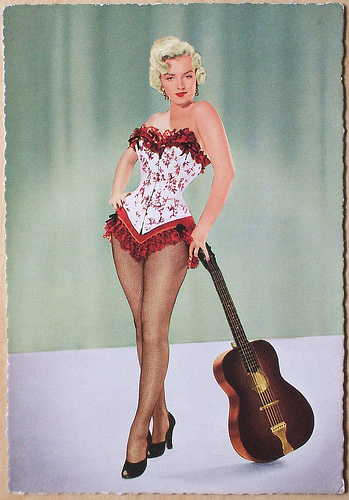
1. "My absolute pride. I have not seen this card very often. I think it was made to promote River of No Return, but I am not sure. On the back it only says Nr. PU 13. Perhaps it is part of a series P(in) U(p) cards. It does not matter: I think it's beautiful, I like to boast of it and I am very careful with it."
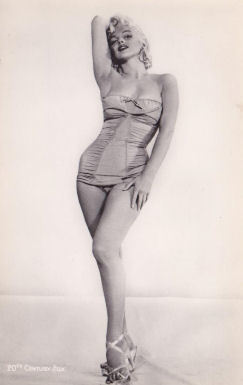
2. "I think this is the kind of card which many beginning film stars had made. I like those cards; they are not vulgar. They radiate a kind of optimism; maybe it has something to do with the period after the Second World War when everybody was relieved and hopeful. There is a similar postcard, but coloured:"

3. "Beautiful! The colours make it more radiant. She has a combination of vulnerability and provocative sex appeal. Marilyn was not the only pin up, of course. She was one of many who tried to make it as an actress. She eventually made it in Hollywood, yet always remained a pin up girl. I have one more original pin up card of her:"
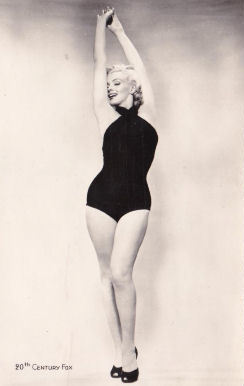
4. "On this card she seems older, with a fuller figure. Wonderful, just like an ordinary woman. Enough about Marilyn's body. She was more than that."
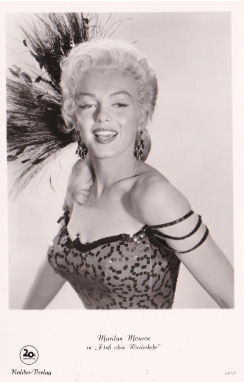
5. "Even on promotional cards for her films, she did not lose the air of being a pin up. This is a German card for River of No Return in 1954. Her sex bomb charisma probably did contribute to her success in movies, yet she did have talent as a comedic actress: Gentlemen Prefer Blondes, Some Like It Hot, and The Seven Year Itch are all funny movies which still stand firm today."
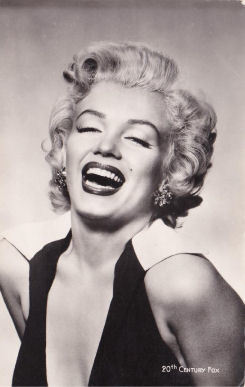
6. "You always had the feeling with Marilyn that she laughed with every fibre of her being. This is such a picture. Strange, when you consider she did not lead a very happy life. She was afraid she would end the way her mother did: in a mental institution. There was definitely a flaw in Marilyn's character, but she tried to laugh it away bravely."
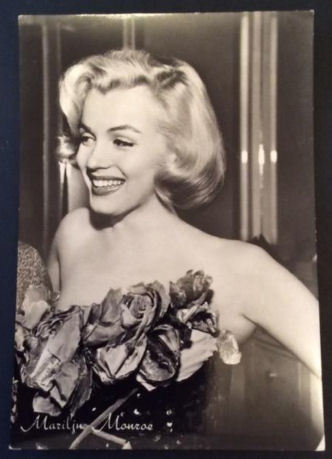
7. "This is an Italian Rotalfoto card. I have no idea when or where it was taken. I guess in 1953 when Gentlemen Prefer Blondes came out. I like it. With the flowers in front of her. I wonder what it would have looked like if the card was coloured..."
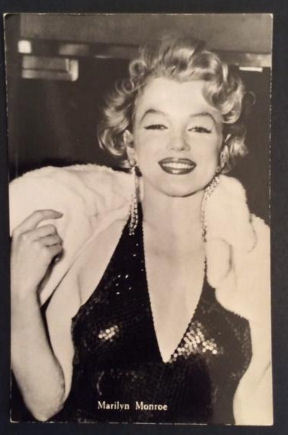
8. "In this picture Marilyn seems to be a celebrated, happy movie star. I will not say it again: that the opposite was true."
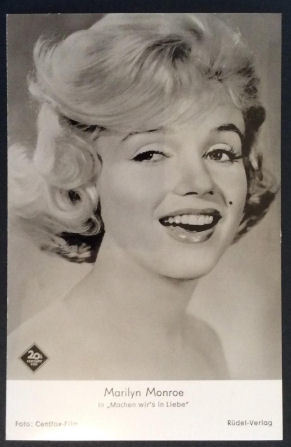
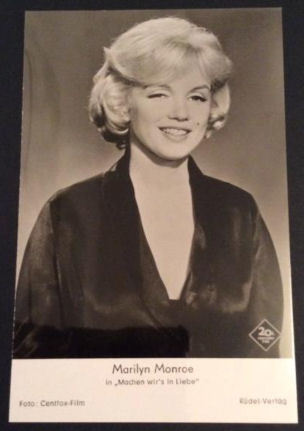
9 and 10. "These are German publicity cards for Let's Make Love (1960). Shooting this movie had been rather stressful: the other main character, Yves Montand , did not speak English and had difficulties to understand and pronounce his lines. Marilyn already had a reputation of coming too late on the set and forgetting her text. On top of that Yves and Marilyn became romantically involved while their respective spouses, Simone Signoret and Arthur Miller, were present. Marilyn looks older in this picture. Is it the hair, her laugh, her more composed appearance? But beautiful as ever."

11. "With Marilyn, you never knew whether she was acting or just being herself. There probably was not much difference between Marilyn, the actress, and Marilyn, the 'original' Norma Jeane Mortenson. I guess it was difficult for her to make a distinction between real life and movies. She always knew when there were cameras present and acted accordingly. Unfortunately, she was always being filmed and photographed and her life became a real-life soap."
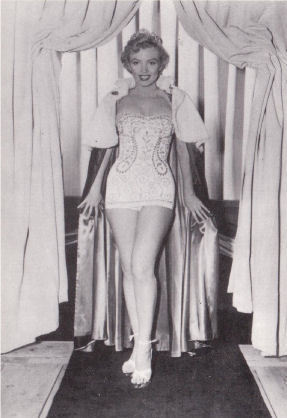
12. "There are numerous modern cards of Marilyn Monroe. Many photographers photographed her (Richard Avedon, Milton Greene, Bernard of Hollywood , Bert Stern....). I cannot choose a favourite photographer, because Marilyn Monroe is photogenic and all cameras love her. Yet, there are also many editors that edit modern cards of her. And I do have a favourite editor: Zoetrope Images. Zoetrope Images publishes cards which all combine this innocent and sex bomb charisma. This card is one of them: Marilyn in We're Not Married (1952).
As you could read: it is difficult to talk/write about Marilyn Monroe and not mention her appearance. She was not fit for a modelling career, because she did not have the right body. She did, however, make it in the world of movies. Her body and appearance certainly helped. But let's not forget she was a talented comedic actress and received a Golden Globe for Best Actress in 1960.
I think it would also be interesting to make a list with actresses and pin up models who resembled Marilyn Monroe. Some thought it a compliment to be compared to Marilyn, others thought it was an insult to be compared to her. Perhaps an idea for the next list?"
Great idea. Thank you so much for this guest post, Carla! And also thanks to Tink for borrowing her postcards for this post!
"A few years ago, it did bring me into contact with a new friend in the UK: she has a very extensive postcard collection of Marilyn Monroe. Once in a while I buy a few from her (modern cards). When I told her about the list, she sent me pictures of a few of her 'old' Marilyn postcards. There is, I think, a difference between our collections: I always have liked (kitschy) pin up cards of the sixties and seventies, so my cards are mostly pictures of Marilyn in bathing suit or sexy outfit. My friend's cards are more virtuous (yes Tink, they are), though that is rather difficult in the case of sex bomb Marilyn Monroe. "
"Here they are, a combination of my friend's and my original postcards:"

1. "My absolute pride. I have not seen this card very often. I think it was made to promote River of No Return, but I am not sure. On the back it only says Nr. PU 13. Perhaps it is part of a series P(in) U(p) cards. It does not matter: I think it's beautiful, I like to boast of it and I am very careful with it."

2. "I think this is the kind of card which many beginning film stars had made. I like those cards; they are not vulgar. They radiate a kind of optimism; maybe it has something to do with the period after the Second World War when everybody was relieved and hopeful. There is a similar postcard, but coloured:"

3. "Beautiful! The colours make it more radiant. She has a combination of vulnerability and provocative sex appeal. Marilyn was not the only pin up, of course. She was one of many who tried to make it as an actress. She eventually made it in Hollywood, yet always remained a pin up girl. I have one more original pin up card of her:"

4. "On this card she seems older, with a fuller figure. Wonderful, just like an ordinary woman. Enough about Marilyn's body. She was more than that."

5. "Even on promotional cards for her films, she did not lose the air of being a pin up. This is a German card for River of No Return in 1954. Her sex bomb charisma probably did contribute to her success in movies, yet she did have talent as a comedic actress: Gentlemen Prefer Blondes, Some Like It Hot, and The Seven Year Itch are all funny movies which still stand firm today."

6. "You always had the feeling with Marilyn that she laughed with every fibre of her being. This is such a picture. Strange, when you consider she did not lead a very happy life. She was afraid she would end the way her mother did: in a mental institution. There was definitely a flaw in Marilyn's character, but she tried to laugh it away bravely."

7. "This is an Italian Rotalfoto card. I have no idea when or where it was taken. I guess in 1953 when Gentlemen Prefer Blondes came out. I like it. With the flowers in front of her. I wonder what it would have looked like if the card was coloured..."

8. "In this picture Marilyn seems to be a celebrated, happy movie star. I will not say it again: that the opposite was true."


9 and 10. "These are German publicity cards for Let's Make Love (1960). Shooting this movie had been rather stressful: the other main character, Yves Montand , did not speak English and had difficulties to understand and pronounce his lines. Marilyn already had a reputation of coming too late on the set and forgetting her text. On top of that Yves and Marilyn became romantically involved while their respective spouses, Simone Signoret and Arthur Miller, were present. Marilyn looks older in this picture. Is it the hair, her laugh, her more composed appearance? But beautiful as ever."

11. "With Marilyn, you never knew whether she was acting or just being herself. There probably was not much difference between Marilyn, the actress, and Marilyn, the 'original' Norma Jeane Mortenson. I guess it was difficult for her to make a distinction between real life and movies. She always knew when there were cameras present and acted accordingly. Unfortunately, she was always being filmed and photographed and her life became a real-life soap."

12. "There are numerous modern cards of Marilyn Monroe. Many photographers photographed her (Richard Avedon, Milton Greene, Bernard of Hollywood , Bert Stern....). I cannot choose a favourite photographer, because Marilyn Monroe is photogenic and all cameras love her. Yet, there are also many editors that edit modern cards of her. And I do have a favourite editor: Zoetrope Images. Zoetrope Images publishes cards which all combine this innocent and sex bomb charisma. This card is one of them: Marilyn in We're Not Married (1952).
As you could read: it is difficult to talk/write about Marilyn Monroe and not mention her appearance. She was not fit for a modelling career, because she did not have the right body. She did, however, make it in the world of movies. Her body and appearance certainly helped. But let's not forget she was a talented comedic actress and received a Golden Globe for Best Actress in 1960.
I think it would also be interesting to make a list with actresses and pin up models who resembled Marilyn Monroe. Some thought it a compliment to be compared to Marilyn, others thought it was an insult to be compared to her. Perhaps an idea for the next list?"
Great idea. Thank you so much for this guest post, Carla! And also thanks to Tink for borrowing her postcards for this post!
Published on March 04, 2017 22:00
March 3, 2017
Maxime Desjardins
Maxime Desjardins (1861-1936) was a French stage and screen actor, who peaked in the French silent cinema of the 1920s. From 1912 Desjardins acted in cinema, first in short films at Pathé Frères and at Eclair, later in feature films by such acclaimed directors as Abel Gance, Julien Duvivier and Henri Diamant-Berger.
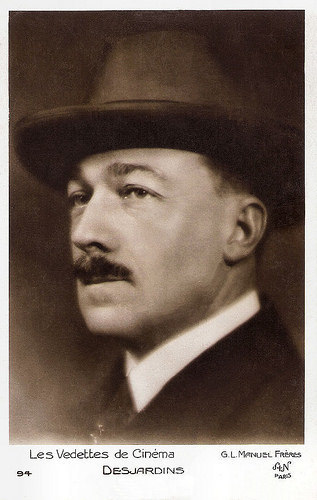
French postcard in the Les Vedettes de Cinéma series by A.N., Paris, no. 94. Photo: G.L. Manuel Frères.
The Three Musketeers
Maxime Desjardins was born in 1861 in Auxerre (Burgundy), France.
He started his stage acting career in Paris around 1890 at the Théâtre de l'Ambigu-Comique, shifting around 1895 to the Théâtre de la Porte-Saint-Martin, and around 1902 to the Théâtre Sarah-Bernhardt. Between 1906 and 1917 he was a regular actor at the Théâtre de l'Odéon, where he often played under the direction of André Antoine.
From 1912 Maxime Desjardins acted in cinema, first in short films at Pathé Frères and at Eclair. For Pathé he appeared in Patrie (Albert Capellani, 1914), starring Henry Krauss and Paul Capellani , and for Eclair in L'aiglon (Emile Chautard, 1913), with Emile Chautard as Napoleon.
In 1916 Desjardins acted in four films at Pathé, including Coeur de Française (Gaston Leprieur, 1916), a propagandist spy drama in which he had the male lead as inventor Aubry opposite André Pascal as his wife. All the actors in the film were acclaimed stage actors, such as Albert Dieudonné .
Desjardins' film career really set off after the First World War. He was Maria Lazare in Abel Gance 's J'accuse (1919) with Séverin-Mars and Romuald Joubé . He played Tréville in Les trois mousquetaires (Henri Diamant-Berger, 1921) with Aimé Simon-Girard , and Commander Doguereau and General petit in L'agonie des aigles (Dominique Bernard-Deschamps, Julien Duvivier, 1922) with Gaby Morlay and Séverin-Mars .
In 1922, he also appeared as the count Marnay in Mimi-Trottin (Henri Andréani, 1922) with Louise Lagarange in the title role, the protagonist François Roquevillard in Les Roquevillard (Julien Duvivier, 1922), the Grandduke in Les mystères de Paris (Charles Burguet, 1922), and king Charles I in Vingt ans après (Henri Diamant-Berger 1922), the sequel to Les trois mousquetaires.
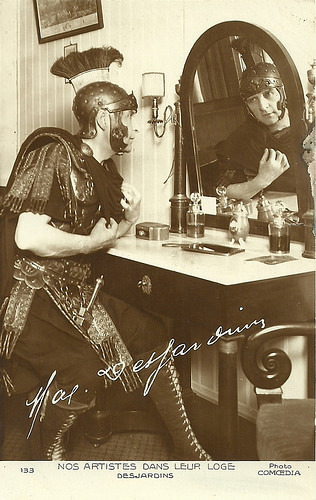
French postcard in the Nos artistes dans leur loge series, no. 133. Photo: Comoedia.
The Titanic disaster
In 1924, Maxim Desjardins was the abbott D'Areynes in La mendiante de Sainte-Sulpice (Charles Burguet, 1924), starring Gaby Morlay and Charles Vanel , and he played Pierre Millot in the murder mystery La double existence de Lord Samsey (Maurice Kéroul, Georges Monca, 1924), starring Geneviève Félix .
In 1925 he was baron D'anvilliers in Nantas (Donatien, 1925), avoiding the suicide of the main character ( Donatien ) by offering him to marry the baron's daughter Flavie (Lucienne Legrand) who expects an illegitimate child.
Afterwards, Desjardins was the Regent in Le bossu (Jean Kemm, 1925), starring Gaston Jacquet , and Jean Sérès in Le coeur des gueux (Alfred Machin, Henri Wulschleger, 1925), starring Ginette Maddie.
In 1926-1927 Desjardins acted again under the direction of Donatien in Simone (1926) and Florine, la fleur du Valois (1927). His last silent film was La grande épreuve (1928), directed by André Dugès-Delzescauts and Alexandre Ryder.
Desjardins did make the passage to sound cinema in Marcel L'Herbier's Le mystère de la chambre jaune (1930), starring Roland Toutain and Huguette Duflos, and the French version of E.A. Dupont's Atlantic, called Atlantis (1930), co-directed by Jean Kemm. He actually had one of the leads in this film based on the Titanic disaster, which co-starred Alice Field and Constant Rémy.
However, Desjardins's sound film career was brief. His last role was in the Agatha Christie adaptation Le coffret de laque (1932), starring Danielle Darrieux , and based on Christie's The Red Lacquer Case.
From 1921 to 1930 Desjardins was also 'sociétaire' at the Comédie-Française, playing in the classic repertory of plays by Molière and Shakespeare, but also more recent authors such as Mérimée and Maeterlinck. Maxime Desjardins died in 1936 in Venice, Italy.
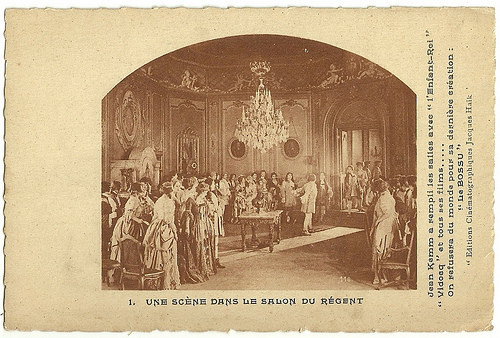
French postcard by Editions Cinématographiques Jacques Haïk, no. 1. Caption: Scene in the Salon of the Regent. Maxime Desjardins as The Regent in Le Bossu ou le Petit Parisien (Jean Kemm, 1925). The story deals with Chevalier Lagardère ( Gaston Jacquet ), who wants to avenge the death of his friend, killed by the Prince of Gonzaga many years ago. The film was based on the homonymous novel by Paul Féval, who was co-scenarist for the film as well. Jealous of the other man's riches, Gonzaga (Marcel Vibert) kills Nevers (Jean Lorette) in a treacherous duel and marries his widow, Aurore ( Claude France ). But Lagardère steals Irène, the child of Nevers and Aurore. Several years after, he returns pretending to be the hunchback of the Rue Quincampoix. He unmasks Gonzaga and holds Irène's (Nilde Duplessy) hand in return. Le Bossu was probably the first production of cinema owner Jacques Haïk, who would become an active French film producer and film distributor in the early sound era.
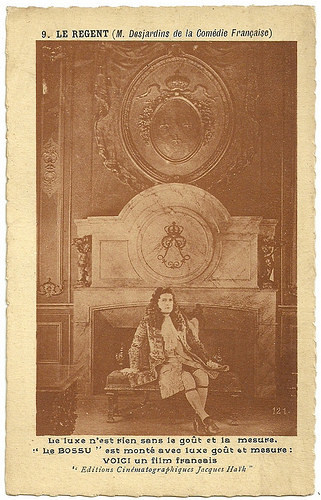
French postcard by Editions Cinématographiques Jacques Haïk, no. 9. Publicity still for Le Bossu ou le Petit Parisien (Jean Kemm, 1925) with Maxime Desjardins as Le Régent. Caption: "Le luxe n'est rien sans le goût et la mesure. 'Le Bossu' est monté avec goût et la mesure: voici un film Français." (Luxury is nothing without taste and measure. 'The Bossu' is mounted with taste and measurement: here is a French film.)
Sources: Wikipedia (French), and .

French postcard in the Les Vedettes de Cinéma series by A.N., Paris, no. 94. Photo: G.L. Manuel Frères.
The Three Musketeers
Maxime Desjardins was born in 1861 in Auxerre (Burgundy), France.
He started his stage acting career in Paris around 1890 at the Théâtre de l'Ambigu-Comique, shifting around 1895 to the Théâtre de la Porte-Saint-Martin, and around 1902 to the Théâtre Sarah-Bernhardt. Between 1906 and 1917 he was a regular actor at the Théâtre de l'Odéon, where he often played under the direction of André Antoine.
From 1912 Maxime Desjardins acted in cinema, first in short films at Pathé Frères and at Eclair. For Pathé he appeared in Patrie (Albert Capellani, 1914), starring Henry Krauss and Paul Capellani , and for Eclair in L'aiglon (Emile Chautard, 1913), with Emile Chautard as Napoleon.
In 1916 Desjardins acted in four films at Pathé, including Coeur de Française (Gaston Leprieur, 1916), a propagandist spy drama in which he had the male lead as inventor Aubry opposite André Pascal as his wife. All the actors in the film were acclaimed stage actors, such as Albert Dieudonné .
Desjardins' film career really set off after the First World War. He was Maria Lazare in Abel Gance 's J'accuse (1919) with Séverin-Mars and Romuald Joubé . He played Tréville in Les trois mousquetaires (Henri Diamant-Berger, 1921) with Aimé Simon-Girard , and Commander Doguereau and General petit in L'agonie des aigles (Dominique Bernard-Deschamps, Julien Duvivier, 1922) with Gaby Morlay and Séverin-Mars .
In 1922, he also appeared as the count Marnay in Mimi-Trottin (Henri Andréani, 1922) with Louise Lagarange in the title role, the protagonist François Roquevillard in Les Roquevillard (Julien Duvivier, 1922), the Grandduke in Les mystères de Paris (Charles Burguet, 1922), and king Charles I in Vingt ans après (Henri Diamant-Berger 1922), the sequel to Les trois mousquetaires.

French postcard in the Nos artistes dans leur loge series, no. 133. Photo: Comoedia.
The Titanic disaster
In 1924, Maxim Desjardins was the abbott D'Areynes in La mendiante de Sainte-Sulpice (Charles Burguet, 1924), starring Gaby Morlay and Charles Vanel , and he played Pierre Millot in the murder mystery La double existence de Lord Samsey (Maurice Kéroul, Georges Monca, 1924), starring Geneviève Félix .
In 1925 he was baron D'anvilliers in Nantas (Donatien, 1925), avoiding the suicide of the main character ( Donatien ) by offering him to marry the baron's daughter Flavie (Lucienne Legrand) who expects an illegitimate child.
Afterwards, Desjardins was the Regent in Le bossu (Jean Kemm, 1925), starring Gaston Jacquet , and Jean Sérès in Le coeur des gueux (Alfred Machin, Henri Wulschleger, 1925), starring Ginette Maddie.
In 1926-1927 Desjardins acted again under the direction of Donatien in Simone (1926) and Florine, la fleur du Valois (1927). His last silent film was La grande épreuve (1928), directed by André Dugès-Delzescauts and Alexandre Ryder.
Desjardins did make the passage to sound cinema in Marcel L'Herbier's Le mystère de la chambre jaune (1930), starring Roland Toutain and Huguette Duflos, and the French version of E.A. Dupont's Atlantic, called Atlantis (1930), co-directed by Jean Kemm. He actually had one of the leads in this film based on the Titanic disaster, which co-starred Alice Field and Constant Rémy.
However, Desjardins's sound film career was brief. His last role was in the Agatha Christie adaptation Le coffret de laque (1932), starring Danielle Darrieux , and based on Christie's The Red Lacquer Case.
From 1921 to 1930 Desjardins was also 'sociétaire' at the Comédie-Française, playing in the classic repertory of plays by Molière and Shakespeare, but also more recent authors such as Mérimée and Maeterlinck. Maxime Desjardins died in 1936 in Venice, Italy.

French postcard by Editions Cinématographiques Jacques Haïk, no. 1. Caption: Scene in the Salon of the Regent. Maxime Desjardins as The Regent in Le Bossu ou le Petit Parisien (Jean Kemm, 1925). The story deals with Chevalier Lagardère ( Gaston Jacquet ), who wants to avenge the death of his friend, killed by the Prince of Gonzaga many years ago. The film was based on the homonymous novel by Paul Féval, who was co-scenarist for the film as well. Jealous of the other man's riches, Gonzaga (Marcel Vibert) kills Nevers (Jean Lorette) in a treacherous duel and marries his widow, Aurore ( Claude France ). But Lagardère steals Irène, the child of Nevers and Aurore. Several years after, he returns pretending to be the hunchback of the Rue Quincampoix. He unmasks Gonzaga and holds Irène's (Nilde Duplessy) hand in return. Le Bossu was probably the first production of cinema owner Jacques Haïk, who would become an active French film producer and film distributor in the early sound era.

French postcard by Editions Cinématographiques Jacques Haïk, no. 9. Publicity still for Le Bossu ou le Petit Parisien (Jean Kemm, 1925) with Maxime Desjardins as Le Régent. Caption: "Le luxe n'est rien sans le goût et la mesure. 'Le Bossu' est monté avec goût et la mesure: voici un film Français." (Luxury is nothing without taste and measure. 'The Bossu' is mounted with taste and measurement: here is a French film.)
Sources: Wikipedia (French), and .
Published on March 03, 2017 22:00
March 2, 2017
Mireille Mathieu
French singer Mireille Mathieu (1946) has recorded over 1200 songs in eleven languages, with more than 150 million albums sold worldwide. She also appeared in a few films.

East-German postcard by VEB Bild und Heimat Reichenbach i.V., no. G 6645, 1972. Photo: Ariola / Marouani / Archiv Weise, Berlin.

East-German postcard by VEB Bild und Heimat Reichenbach i.V., no. G 6646. Photo: Ariola / Marouani / Archiv Weise.
Very stubborn
Mireille Mathieu was born in 1946 in Avignon, France. She was the eldest daughter of fourteen children of Roger and Marcelle Mathieu. The Mathieu family lived in poverty, with a huge improvement in their living conditions in 1954, when subsidised housing was built in the Malpeigné quarter. Roger once dreamed of becoming a singer, but his father disapproved, inspiring him to have one of his children learn to sing with him in church. Mireille included his operatic voice on her 1968 Christmas album, where it was mixed in with the Minuit Chrétiens song.
Mireille's first paid performance before an audience, at age four, was rewarded with a lollipop when she sang on Christmas Eve 1950 during Midnight Mass. A defining moment was seeing Édith Piaf sing on television. Mireille performed poorly in elementary school because of dyslexia, requiring an extra year to graduate.
At age 14, she abandoned higher education, and began work in a local factory where she helped with the family income and paid for her singing lessons. Popular at work, she often sang songs at lunch, or while working. Mathieu began her career by participating in an annual singing contest in Avignon called On Chante dans mon Quartier (We sing in my neighbourhood). Talent scouts made this a worthwhile event for singers within hundreds of kilometers to participate in.
Self-described as very stubborn in her autobiography, she wrote about singing love songs that the audience thought were inappropriate for a young girl. Thus, losing to Michèle Torr in 1962 when she sang Les cloches de Lisbonne at the first contest, and losing again in 1963 singing Édith Piaf's L'Hymne à l'amour. In 1964, though, she won the event with another Piaf song: La Vie en rose.
Her win was rewarded with a free trip to Paris, and a pre-audition for the televised talent show Jeu de la Chance (Game of Luck). This was a talent segment of the popular program Télé-Dimanche (TV Sunday), where amateur singers competed for audience and telephone votes.
During a 1965 summer gala, she met her future manager Johnny Stark. Stark had worked with singers such as Yves Montand , and the relationship between him and Mathieu is often described as resembling that between Colonel Tom Parker and Elvis Presley. Stark is credited with making her a star and the successor to Piaf. By 1968, under his careful management, she was France's most popular singer.
Mathieu appeared in cameos in several films, including the Russian production Zhurnalist/The Journalist (Sergey Gerasimov, 1967), the French comedy L'événement le plus important depuis que l'homme a marché sur la lune/A Slightly Pregnant Man (Jacques Demy, 1973) with Catherine Deneuve , the comedy La bonne année/Happy New Year (Claude Lelouch, 1973) and the French short C'est plus fort que moi/It’s stronger than me (Gilles Marchand, 1999).
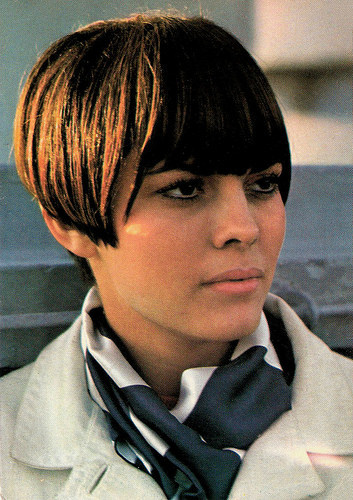
Belgian postcard by Edt. Decker, Brussels, no. A 106.
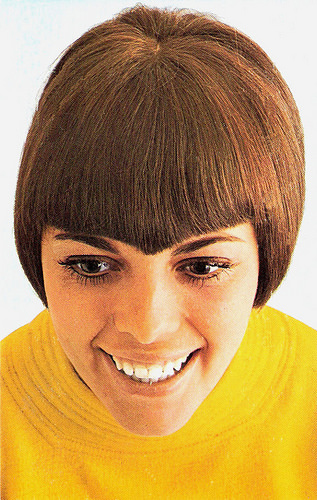
French postcard by Ed. Lyna, Paris, no. 2011, offered by Corvisart.
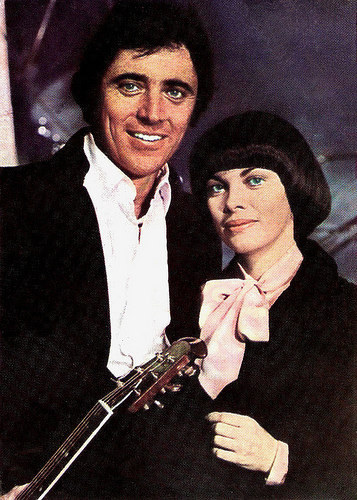
Romanian postcard by Casa Filmului Acin. With Sacha Distel .
The Sparrow from Avignon
In 1965, Mireille Mathieu was invited to Paris to sing on the TV show Song Parade and competed live on the Sunday 21 November 1965 episode of Jeu de la Chance. Both the studio audience and telephone voters gave her a slight lead over five-time winner Georgette Lemaire, so the producers called it a tie.
Johnny Stark officially became her manager that night, and helped prepare Mireille to win the contest the following week and bury Georgette. In the middle of her seven consecutive performances on Télé-Dimanche, she performed a concert at the Paris Olympia, which propelled her to stardom. She performed the only three Édith Piaf songs she had memorized, and was hailed in the press, in France and abroad, as the Piaf d'Avignon (Sparrow from Avignon), in reference to Piaf's nickname Sparrow of the Streets.
Stark then abandoned the Piaf direction he was taking her. The Olympia performance convinced a skeptical Paul Mauriat to work with Mathieu, and song writer André Pascal joined forces to develop her into a successful act. Together they wrote new modern material for her: Mon crédo, Viens dans ma rue, La première étoile and many other hit songs.
Her first album En Direct de L'Olympia was released in 1966. Highly acclaimed, the album made her a star outside France. A regular early contributor of material was Francis Lai, who wrote two songs: C'est ton nom, and Un homme et une femme for her first album, and often accompanied her with his accordion on television. Mireille spent all of 1966 and 1967 touring.
Her first major purchases were a vehicle for her father's business and a large home for her parents and siblings. She had a telephone installed for the family, so her parents no longer had to go to the pharmacy to talk to her while she was in Paris. Mireille sang twice at the London Palladium during royal performances in 1967, and in 1969. Her French cover of Engelbert Humperdinck 's The Last Waltz (La dernière valse) generated much publicity in Great Britain and became a hit. She also toured Canada and the United States, where she appeared on The Ed Sullivan Show and The Danny Kaye Show. While on a visit to Hollywood, she met Elvis Presley, and in Las Vegas, Nevada she sang with Dean Martin and Frank Sinatra.
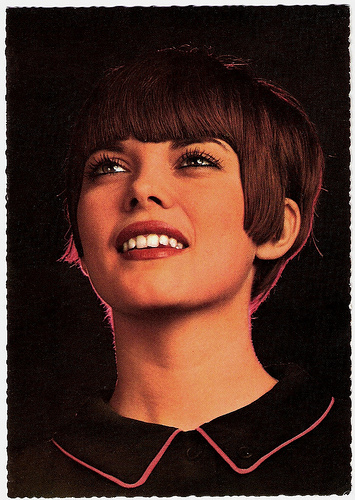
French postcard by PSG, no. 475. Photo: Alain / Disques Barclay.

French postcard by PSG, no. 1290. Photo: Alain / Barclay.

French postcard by E.D.U.G., Paris, no. 509. Photo: Sam Lévin.
A conservative relic
During the next decades, Mireille Mathieu remained a popular artist in France and Europe. In 1971, Barclay was unable to meet the demands for records. Johnny Stark then made a contract for Philips Records to issue all the singles, and EPs, resulting in a US$1 Million lawsuit from Barclay for breach of contract. Barclay's contract was to run until 1972.
In 1972, Mathieu toured Canada and produced a live album. Johnny Stark suffered his first heart attack while making arrangements for this concert. In 1986, Mathieu performed a concert in Beijing, China. In 1988, Mathieu published her autobiography with co-author Jacqueline Cartier, Oui Je Crois (Yes, I Believe) which is taken from the lyrics of Mon crédo, her first recording.
The book was seen as a final chapter in her career. The French public had pretty much disowned her, as a conservative relic. She was considered a pre-revolution (1968) Gaullist figurehead. In 1989, President François Mitterrand invited Mathieu to sing a tribute to General Charles de Gaulle. Johnny Stark died the same year after his second heart attack.
Her sister Monique stepped in to become her business manager, and the two women have remained profitable in the industry ever since. In 1990, she gave a series of concerts at the Palais des Congrès in Paris. In 1993, she released two albums devoted to her idol, Édith Piaf , essentially retracing her roots. One album was in French; the other, in German.
In January 1996, Vous lui Direz was released, followed in 1999, by a German album Alles nur ein Spiel, with Francis Lai on accordion. In 2002, Mathieu released her thirty-seventh French album: De tes Mains, followed by a series of concerts at the Paris Olympia. In 2008, she was a guest of Prime Minister Vladimir Putin in Moscow, and performed a concert in his honor. The two visited the tent of visiting Libyan leader Muammar Gaddafi.
In 2010, Mireille Mathieu was awarded the Russian Medal of Friendship by President Dmitry Medvedev In January 2011, Mireille was promoted from Chevalier (1999) to Officier of the Légion d'honneur. Mathieu has never been married and has no children. She has recorded about 1200 songs in 9 different languages and has released 38 studio albums to date.
Original scopitone clip with Mireille Mathieu singing Mon crédo (1966). Source: TBH (YouTube).
Mireille Mathieu sings La vie en rose. Source: Hugo Reyes (YouTube).
Sources: Wikipedia and

East-German postcard by VEB Bild und Heimat Reichenbach i.V., no. G 6645, 1972. Photo: Ariola / Marouani / Archiv Weise, Berlin.

East-German postcard by VEB Bild und Heimat Reichenbach i.V., no. G 6646. Photo: Ariola / Marouani / Archiv Weise.
Very stubborn
Mireille Mathieu was born in 1946 in Avignon, France. She was the eldest daughter of fourteen children of Roger and Marcelle Mathieu. The Mathieu family lived in poverty, with a huge improvement in their living conditions in 1954, when subsidised housing was built in the Malpeigné quarter. Roger once dreamed of becoming a singer, but his father disapproved, inspiring him to have one of his children learn to sing with him in church. Mireille included his operatic voice on her 1968 Christmas album, where it was mixed in with the Minuit Chrétiens song.
Mireille's first paid performance before an audience, at age four, was rewarded with a lollipop when she sang on Christmas Eve 1950 during Midnight Mass. A defining moment was seeing Édith Piaf sing on television. Mireille performed poorly in elementary school because of dyslexia, requiring an extra year to graduate.
At age 14, she abandoned higher education, and began work in a local factory where she helped with the family income and paid for her singing lessons. Popular at work, she often sang songs at lunch, or while working. Mathieu began her career by participating in an annual singing contest in Avignon called On Chante dans mon Quartier (We sing in my neighbourhood). Talent scouts made this a worthwhile event for singers within hundreds of kilometers to participate in.
Self-described as very stubborn in her autobiography, she wrote about singing love songs that the audience thought were inappropriate for a young girl. Thus, losing to Michèle Torr in 1962 when she sang Les cloches de Lisbonne at the first contest, and losing again in 1963 singing Édith Piaf's L'Hymne à l'amour. In 1964, though, she won the event with another Piaf song: La Vie en rose.
Her win was rewarded with a free trip to Paris, and a pre-audition for the televised talent show Jeu de la Chance (Game of Luck). This was a talent segment of the popular program Télé-Dimanche (TV Sunday), where amateur singers competed for audience and telephone votes.
During a 1965 summer gala, she met her future manager Johnny Stark. Stark had worked with singers such as Yves Montand , and the relationship between him and Mathieu is often described as resembling that between Colonel Tom Parker and Elvis Presley. Stark is credited with making her a star and the successor to Piaf. By 1968, under his careful management, she was France's most popular singer.
Mathieu appeared in cameos in several films, including the Russian production Zhurnalist/The Journalist (Sergey Gerasimov, 1967), the French comedy L'événement le plus important depuis que l'homme a marché sur la lune/A Slightly Pregnant Man (Jacques Demy, 1973) with Catherine Deneuve , the comedy La bonne année/Happy New Year (Claude Lelouch, 1973) and the French short C'est plus fort que moi/It’s stronger than me (Gilles Marchand, 1999).

Belgian postcard by Edt. Decker, Brussels, no. A 106.

French postcard by Ed. Lyna, Paris, no. 2011, offered by Corvisart.

Romanian postcard by Casa Filmului Acin. With Sacha Distel .
The Sparrow from Avignon
In 1965, Mireille Mathieu was invited to Paris to sing on the TV show Song Parade and competed live on the Sunday 21 November 1965 episode of Jeu de la Chance. Both the studio audience and telephone voters gave her a slight lead over five-time winner Georgette Lemaire, so the producers called it a tie.
Johnny Stark officially became her manager that night, and helped prepare Mireille to win the contest the following week and bury Georgette. In the middle of her seven consecutive performances on Télé-Dimanche, she performed a concert at the Paris Olympia, which propelled her to stardom. She performed the only three Édith Piaf songs she had memorized, and was hailed in the press, in France and abroad, as the Piaf d'Avignon (Sparrow from Avignon), in reference to Piaf's nickname Sparrow of the Streets.
Stark then abandoned the Piaf direction he was taking her. The Olympia performance convinced a skeptical Paul Mauriat to work with Mathieu, and song writer André Pascal joined forces to develop her into a successful act. Together they wrote new modern material for her: Mon crédo, Viens dans ma rue, La première étoile and many other hit songs.
Her first album En Direct de L'Olympia was released in 1966. Highly acclaimed, the album made her a star outside France. A regular early contributor of material was Francis Lai, who wrote two songs: C'est ton nom, and Un homme et une femme for her first album, and often accompanied her with his accordion on television. Mireille spent all of 1966 and 1967 touring.
Her first major purchases were a vehicle for her father's business and a large home for her parents and siblings. She had a telephone installed for the family, so her parents no longer had to go to the pharmacy to talk to her while she was in Paris. Mireille sang twice at the London Palladium during royal performances in 1967, and in 1969. Her French cover of Engelbert Humperdinck 's The Last Waltz (La dernière valse) generated much publicity in Great Britain and became a hit. She also toured Canada and the United States, where she appeared on The Ed Sullivan Show and The Danny Kaye Show. While on a visit to Hollywood, she met Elvis Presley, and in Las Vegas, Nevada she sang with Dean Martin and Frank Sinatra.

French postcard by PSG, no. 475. Photo: Alain / Disques Barclay.

French postcard by PSG, no. 1290. Photo: Alain / Barclay.

French postcard by E.D.U.G., Paris, no. 509. Photo: Sam Lévin.
A conservative relic
During the next decades, Mireille Mathieu remained a popular artist in France and Europe. In 1971, Barclay was unable to meet the demands for records. Johnny Stark then made a contract for Philips Records to issue all the singles, and EPs, resulting in a US$1 Million lawsuit from Barclay for breach of contract. Barclay's contract was to run until 1972.
In 1972, Mathieu toured Canada and produced a live album. Johnny Stark suffered his first heart attack while making arrangements for this concert. In 1986, Mathieu performed a concert in Beijing, China. In 1988, Mathieu published her autobiography with co-author Jacqueline Cartier, Oui Je Crois (Yes, I Believe) which is taken from the lyrics of Mon crédo, her first recording.
The book was seen as a final chapter in her career. The French public had pretty much disowned her, as a conservative relic. She was considered a pre-revolution (1968) Gaullist figurehead. In 1989, President François Mitterrand invited Mathieu to sing a tribute to General Charles de Gaulle. Johnny Stark died the same year after his second heart attack.
Her sister Monique stepped in to become her business manager, and the two women have remained profitable in the industry ever since. In 1990, she gave a series of concerts at the Palais des Congrès in Paris. In 1993, she released two albums devoted to her idol, Édith Piaf , essentially retracing her roots. One album was in French; the other, in German.
In January 1996, Vous lui Direz was released, followed in 1999, by a German album Alles nur ein Spiel, with Francis Lai on accordion. In 2002, Mathieu released her thirty-seventh French album: De tes Mains, followed by a series of concerts at the Paris Olympia. In 2008, she was a guest of Prime Minister Vladimir Putin in Moscow, and performed a concert in his honor. The two visited the tent of visiting Libyan leader Muammar Gaddafi.
In 2010, Mireille Mathieu was awarded the Russian Medal of Friendship by President Dmitry Medvedev In January 2011, Mireille was promoted from Chevalier (1999) to Officier of the Légion d'honneur. Mathieu has never been married and has no children. She has recorded about 1200 songs in 9 different languages and has released 38 studio albums to date.
Original scopitone clip with Mireille Mathieu singing Mon crédo (1966). Source: TBH (YouTube).
Mireille Mathieu sings La vie en rose. Source: Hugo Reyes (YouTube).
Sources: Wikipedia and
Published on March 02, 2017 22:00
March 1, 2017
Die Tochter des Gräfin Stachowska (1917)
During the First World War, the German government stimulated the film industry and the star system in Germany by subsidising film postcards. It worked. One of the most popular series was the Film Sterne series by publisher Rotophot. A typical example is the set of postcards made for Die Tochter der Gräfin Stachowska/The Daughter of Countess Stachowksa (Otto Rippert, 1917), produced by the great Erich Pommer for the Decla studio. The film's star is Hella Moja.
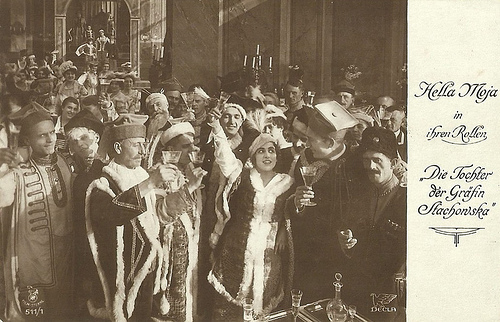
German postcard by Rotophot in the Film Sterne series, no. 511/1. Photo: Decla. Publicity still for Die Tochter der Gräfin Stachowska (Otto Rippert, 1917) with Hella Moja .
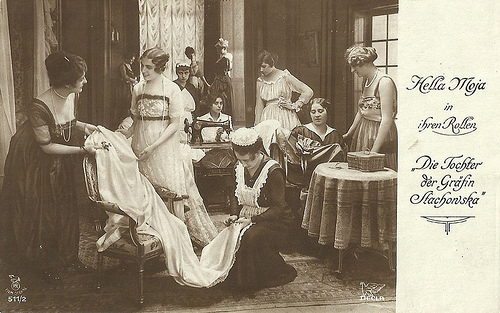
German postcard by Rotophot in the Film Sterne series, no. 511/2. Photo: Decla. Publicity still for Die Tochter der Gräfin Stachowska (Otto Rippert, 1917) with Hella Moja .
A poor Polish aristocrat
During the First World War and the following years Hella Moja (1890-1951) was one of the most popular stars of the German silent cinema. There was even a Hella Moja serial and in 1918 she founded her own film company.
In Die Tochter des Gräfin Stachowska/The Daughter of Countess Stachowksa (Otto Rippert, 1917) Moja plays a poor Polish aristocrat, who marries a rich man. She loves another man, but eventually returns to the other.
Die Tochter der Gräfin Stachowska was scripted by Paul Otto and photographed by Carl Hoffmann. The film was co-produced by Moja and legendary producer Erich Pommer. Moja's co-actors were Werner Krauss , Tony Tetzlaff, Thea Sandten, and a young Hans Albers , whose fourth film this was and his first substantial part.
Our sources differ about which film company produced the film. Filmportal.de indicates this was a Decla-Film-Gesellschaft Holz & Co., but the Murnau Stiftung claims it was produced by Moja's own film company Hella Moja Film-GmbH. We think Filmportal.de is right here. German Wikipedia writes that Moja founded her film company in 1918, and the postcards definitively show the Decla logo.
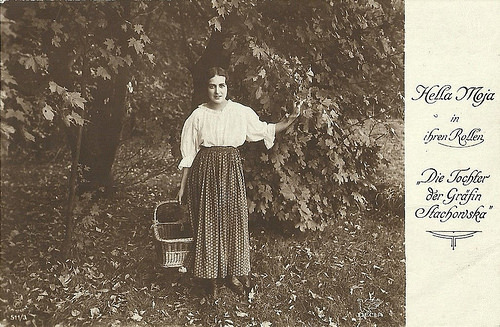
German postcard by Rotophot in the Film Sterne series, no. 511/3. Photo: Decla. Publicity still for Die Tochter der Gräfin Stachowska (Otto Rippert, 1917) with Hella Moja .
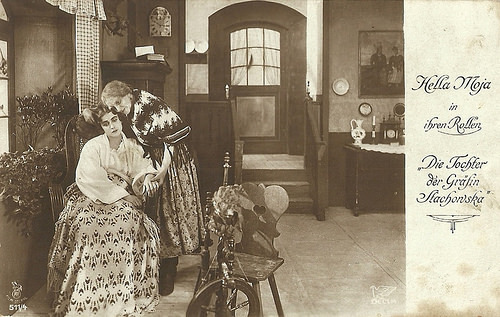
German postcard by Rotophot in the Film Sterne series, no. 511/4. Photo: Decla. Publicity still for Die Tochter der Gräfin Stachowska (Otto Rippert, 1917) with Hella Moja .
Sources: Filmportal.de, Murnau Stiftung (German), Wikipedia (German) and IMDb.

German postcard by Rotophot in the Film Sterne series, no. 511/1. Photo: Decla. Publicity still for Die Tochter der Gräfin Stachowska (Otto Rippert, 1917) with Hella Moja .

German postcard by Rotophot in the Film Sterne series, no. 511/2. Photo: Decla. Publicity still for Die Tochter der Gräfin Stachowska (Otto Rippert, 1917) with Hella Moja .
A poor Polish aristocrat
During the First World War and the following years Hella Moja (1890-1951) was one of the most popular stars of the German silent cinema. There was even a Hella Moja serial and in 1918 she founded her own film company.
In Die Tochter des Gräfin Stachowska/The Daughter of Countess Stachowksa (Otto Rippert, 1917) Moja plays a poor Polish aristocrat, who marries a rich man. She loves another man, but eventually returns to the other.
Die Tochter der Gräfin Stachowska was scripted by Paul Otto and photographed by Carl Hoffmann. The film was co-produced by Moja and legendary producer Erich Pommer. Moja's co-actors were Werner Krauss , Tony Tetzlaff, Thea Sandten, and a young Hans Albers , whose fourth film this was and his first substantial part.
Our sources differ about which film company produced the film. Filmportal.de indicates this was a Decla-Film-Gesellschaft Holz & Co., but the Murnau Stiftung claims it was produced by Moja's own film company Hella Moja Film-GmbH. We think Filmportal.de is right here. German Wikipedia writes that Moja founded her film company in 1918, and the postcards definitively show the Decla logo.

German postcard by Rotophot in the Film Sterne series, no. 511/3. Photo: Decla. Publicity still for Die Tochter der Gräfin Stachowska (Otto Rippert, 1917) with Hella Moja .

German postcard by Rotophot in the Film Sterne series, no. 511/4. Photo: Decla. Publicity still for Die Tochter der Gräfin Stachowska (Otto Rippert, 1917) with Hella Moja .
Sources: Filmportal.de, Murnau Stiftung (German), Wikipedia (German) and IMDb.
Published on March 01, 2017 22:00
February 28, 2017
Jack Hawkins
Square-jawed, craggy-looking Jack Hawkins (1910-1973) was an English actor who worked on stage and in film from the 1930s until the 1970s. One of the most popular British film stars of the 1950s, he often played coolly efficient military officers in such films as The Cruel Sea (1953), Bridge on the River Kwai (1957), and Lawrence of Arabia (1962).
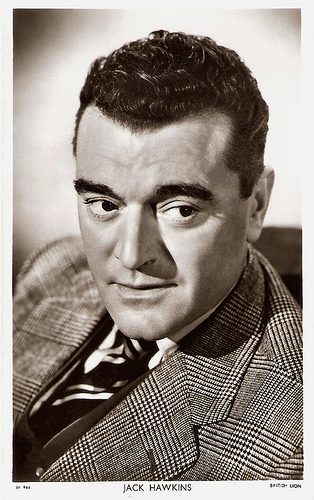
British postcard in the Picturegoer series, no. W 44. Photo: British Lion.

Dutch postcard by Uitg. Takken, Utrecht, no. 8304. Photo: Columbia. Photo: The Bridge on the River Kwai (David Lean, 1957).
Journey's End
John Edward ‘Jack’ Hawkins was born in London in 1910. He was the youngest child to Thomas George Hawkins, a master builder and Phoebe (nee Goodman). He was educated at Wood Green’s Trinity County Grammar School, where, aged eight, he joined the school choir. By the age of ten by, his singing had developed so well that he had joined the local operatic society, making his stage debut in Patience by Gilbert and Sullivan.
His parents enrolled him in the Italia Conti Academy and whilst he was studying there he made his London stage debut, when aged eleven, playing the Elf King in Where the Rainbow Ends, a Christmas pantomime that also included the young Noël Coward. The following year, aged 14, he played the page in a production of Saint Joan by George Bernard Shaw.
Five years later he was in a production of Beau Geste alongside Laurence Olivier . By the age of 18, he appeared on Broadway as Second Lieutenant Hibbert in R. C. Sherriff’s Journey’s End, directed by James Whale. At 21, he was back in London playing a young lover in Autumn Crocus. He married his leading lady, Jessica Tandy.
In the 1930s Hawkins' focus was on the stage. He worked in the companies of Sybil Thorndike , John Gielgud and Basil Dean. His performances included Port Said by Emlyn Williams (1931), Below the Surface by HL Stoker and LS Hunt (1932), Red Triangle by Val Gielgud (1932), Service by CI Anthony, for director Basil Dean (1933), One of Us by Frank Howard, As You Like It by William Shakespeare (1933) and Iron Flowers by Cecil Lewis (1933), with his wife Jessica Tandy.
He did start appearing in films, predominantly ‘quota quickies’ of the time: including an uncredited bit role in the mystery Birds of Prey (Basil Dean, 1930), his first proper role in the sound version of Alfred Hitchcock's The Lodger (Maurice Elvey, 1932), starring Ivor Novello , the comedy The Good Companions (Victor Saville, 1933), and the romance Autumn Crocus (Basil Dean, 1934).
Stage roles included Iron Mistress (1934) by Arthur Macrae; then an open air Shakespeare festival - As You Like It (1934) with Anna Neagle , Twelfth Night (1934), and Comedy of Errors (1934). In the years leading up to the Second World War, he often worked with Gielgud, most notably in the 1940 production of Oscar Wilde’s The Importance of Being Earnest, in which Hawkins excelled in the role of Algernon Moncrieff.
Films in the late 1930s included the comedy Beauty and the Barge (Henry Edwards, 1937) with Gordon Harker , the crime film The Frog (Jack Raymond, 1937), the war film Who Goes Next? (Maurice Elvey, 1938), and the crime film The Flying Squad (Herbert Brenon, 1940).

Italian postcard by Bromostampa, Milano, no. 78.
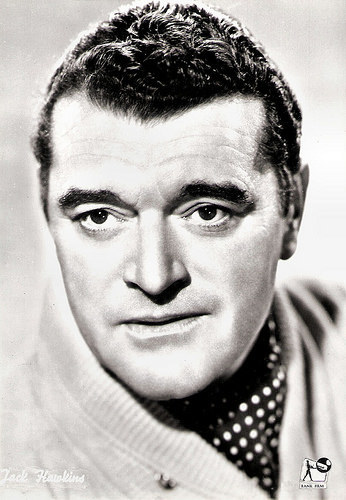
Italian postcard by Bromofoto, Milano, no. 1288. Photo: Rank Film. Publicity still for The Long Arm (Charles Frend, 1956).
The fourth most popular British star
During World War II, Jack Hawkins volunteered as an officer with the Royal Welch Fusiliers. He spent most of his military career arranging entertainment for the British forces in India. One of the actresses who came out to India was Doreen Lawrence who became his second wife after the war. During his military service he made The Next of Kin (Thorold Dickenson, 1942) for Ealing Studios.
Hawkins left the army in July 1946. Two weeks later he appeared on stage in The Apple Cart at ten pounds a week. The following year he starred in Othello, to a mixed reception. Hawkins's wife became pregnant and he became concerned about his future. He decided to accept a contract with Alexander Korda for three years at £50 a week.
Hawkins had been recommended to Korda by the latter's production executive, Bill Bryden, who was married to Elizabeth Allen , who had worked with Hawkins. The association began badly when Hawkins was cast in Korda's notorious flop Bonnie Prince Charlie (Anthony Kimmins, 1948) as Lord George Murray. However he followed it with a good role in the successful, highly acclaimed The Fallen Idol (1948) for Carol Reed. He played Detective Ames opposite Ralph Richardson .
Also acclaimed was the war-time thriller The Small Back Room (1949), for Powell and Pressburger. Hawkins then impressed as the villain in State Secret (Sidney Gilliat, 1950), with Douglas Fairbanks Jnr. He was hired by 20th Century Fox to support Tyrone Power and Orson Welles in an expensive historical epic, The Black Rose (Henry Hathaway, 1950).
He made another film with Powell and Pressburger for Korda, The Elusive Pimpernel (1950), playing The Prince of Wales. Hawkins played the lead in The Adventurers (David MacDonald, 1951), shot in South Africa, then he had a good role in another Hollywood-financed film shot in England, No Highway in the Sky (Henry Koster, 1951), with James Stewart. It was followed by a British thriller directed by and starring Ralph Richardson , Home at Seven (1952). In the spring of 1951 he went to Broadway and played Mercutio in a production of Romeo and Juliet with Olivia de Havilland.
Hawkins became a star with the release of three successful films in which he played stern but sympathetic authority figures: Angels One Five (George More O'Ferrall, 1951), as a RAF officer during the war; The Planter's Wife (Ken Annakin, 1952), as a rubber planter combating communists in the Malayan Emergency with Claudette Colbert; and Mandy (Alexander Mackendrick, 1952), the gruffly, humane headmaster of a school for deaf children. All films ranked among the top ten most popular films at the British box office in 1952 and British exhibitors voted him the fourth most popular British star at the local box office.

British postcard by L.D. LTD., London, in the Film Star Autograph Portrait series, no. 96. Photo: J. Arthur Rank Organisation LTD. Publicity still for The Seekers (Ken Annakin, 1954).
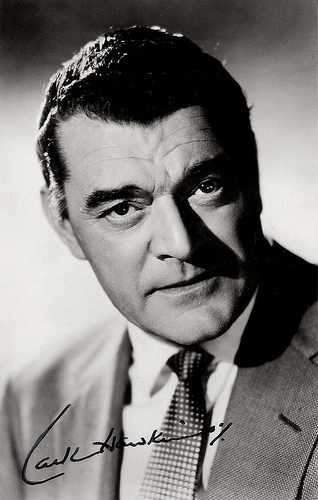
British autograph card.
The Bridge on the River Kwai
Jack Hawkins consolidated his new status with The Cruel Sea (Charles Frend, 1953). Suffering from lifelong real life sea sickness, he played the driven Captain Ericson of the Compass Rose, a naval officer during the war. Clive Saunders at BritMovie : “The film is a triumph as an unsentimental depiction of the ugly realities of war at sea, the hardships the crews go through, their highs and lows together, the sense of pride when the job is done. Hawkins is superb as the Captain of the Corvette, Saltash Castle, tasked with protecting the convoys, and gives a vivid portrayal of a man with the heavy responsibility of making life-or-death decisions that affect hundreds of his colleagues.”
The Cruel Sea was the most successful film of the year and saw Hawkins voted the most popular star in Britain regardless of nationality. Malta Story (Alexander Mackendrick, 1953) was another military story, with Hawkins as an RAF officer in the Siege of Malta during the war. It too was a hit, the ninth most popular film in Britain in 1953. He had a guest role in Twice Upon a Time (1953) for Emeric Pressburger.
The Seekers (Ken Annakin, 1954) was partly shot in New Zealand and cast Hawkins in a rare romantic role. It was followed by The Prisoner (Peter Glenville, 1955), an unconventional drama, playing the interrogator of a priest ( Alec Guinness ). None of these films were that successful but Hawkins was still voted the fifth biggest star at the British box office for 1954, and the most popular British one.
Hawkins received a Hollywood offer to play a pharaoh in Land of the Pharaohs (Howard Hawks, 1955). He returned home to make an Ealing comedy, Touch and Go (Michael Truman, 1955), which was not particularly popular. He was more comfortably cast as a police officer in The Long Arm (Charles Frend, 1956) and a test pilot in The Man in the Sky (Charles Crichton, 1957). He was an insurance investigator in Sidney Gilliat's Fortune Is a Woman (1957).
Hawkins's career received a major boost when given the third lead in The Bridge on the River Kwai (David Lean, 1957), supporting William Holden and Alec Guinness as Major Warden, the fervent demolition expert. This was a massive hit and highly acclaimed. Clive Saunders: “Hawkins was somewhat unlucky not to win either of the Best Supporting Actor Awards for his portrayal of the determined and indomitable explosives expert, played with the archetypal ‘stiff-upper-lip, jolly good show’ attitude of a British officer, intent on completing his mission at all costs.”
Hawkins next played the lead role of Inspector George Gideon, the over-worked police detective in Gideon's Day/Gideon of Scotland Yard (John Ford, 1958). He had a good role as a double agent in a war film, The Two-Headed Spy (Andre de Toth, 1958) then was given another third lead in a Hollywood blockbuster Ben-Hur (William Wyler, 1959), playing the Roman soldier who befriends Charlton Heston. Melinda Hildebrandt in the Encyclopedia of British Film : “his most commanding turn of all, Quintus Arrius.”
Ben-Hur was even more successful than The Bridge on the River Kwai. In 1958, Hawkins was awarded the CBE (Commander of the Order of the British Empire) in the Queen's Birthday Honours List for his services to drama. He appeared as one of The Four Just Men (1959) in the Sapphire Films TV series for ITV, one of the most ambitious British TV series ever made.
In sharp contrast to his conservative screen image, Hawkins was politically liberal, and an emotional man. One of his favourite films, the heist movie The League of Gentlemen (Basil Dearden, 1960), was considered quite groundbreaking for its time in its references to sex. The film was popular at the British box office. However, though initially sought for the role of a gay barrister in Victim (Basil Dearden, 1960), the ground-breaking film examining the persecution and blackmail of homosexuals. Reportedly, Hawkins turned it down fearing that it might conflict with his masculine image. The role was eventually played by Dirk Bogarde .
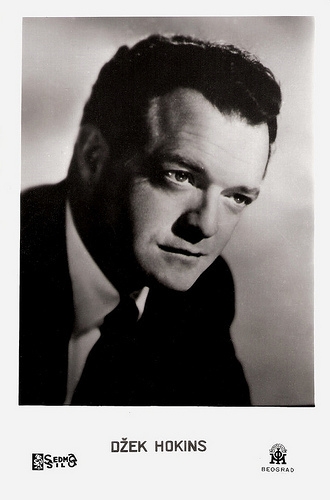
Yugoslavian postcard by Sedmo Silo / IOM, Beograd.
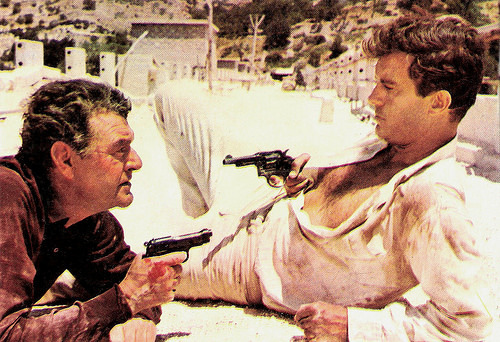
Italian postcard. Photo: Dear Film. Publicity still for Masquerade (Basil Dearden, 1965).
Lawrence of Arabia
A three-packet-a-day chain smoker, Jack Hawkins began experiencing voice problems in the late 1950s. Unknown to the public he had undergone cobalt treatment in 1959 for what was then described as a secondary condition of the larynx, but which was probably cancer. Hawkins became worried about his voice and was concerned he would lose it. This caused him to take any work going.
This may explain why he took the part of General Cornwallis in the French-Italian biographical epic Lafayette (Jean Dréville, 1961). He was third lead to Shirley MacLaine and Laurence Harvey in Two Loves (Charles Walters, 1961), and supported Rosalind Russell in Five Finger Exercise (Daniel Mann, 1962).
He was in another big hit in Lawrence of Arabia (David Lean, 1962), as General Allenby. Zulu (Cy Endfield, 1964) gave him a good role as Otto Witt, a pacifist missionary with a drink problem, continually imploring Stanley Baker ‘s men to lay down their arms or die. It was however clearly a support part and Hawkins' days as a star seemed to be over.
He had supporting parts in Guns at Batasi (John Guillermin, 1964) and Lord Jim (Richard Brooks, 1965). In December 1965, Hawkins was diagnosed with throat cancer. His entire larynx was removed in January 1966. In March of that year, he appeared at a royal screening of Born Free attended by Queen Elizabeth II and received a standing ovation. Thereafter his performances were dubbed, often (with Hawkins's approval) by Robert Rietti or Charles Gray. Hawkins continued to smoke after losing his voice. In private, he used a mechanical larynx to aid his speech.
He resumed his acting career, with his voice dubbed and dialogue kept to a minimum: Shalako (Edward Dmytryk, 1968) with Sean Connery and Brigitte Bardot , Great Catherine (Gordon Flemyng, 1968) featuring Jeanne Moreau , and the musical Oh! What a Lovely War (Richard Attenborough, 1969). He had an operation to restore his voice in 1968. It did not work; Hawkins could talk but it was a in a croaking voice.
Some rare comedies followed: Monte Carlo or Bust (Ken Annakin, 1969), Twinky (Richard Donner, 1970), and The Adventures of Gerard (Jerzy Skolimowski, 1970). More typical were Waterloo (Sergei Bondarchuk, 1970), When Eight Bells Toll (Etienne Perier, 1971) with Anthony Hopkins, Nicholas and Alexandra (Franklin J. Schaffner, 1971) and Kidnapped (Delbert Mann, 1971) with Michael Caine .
The Last Lion (Elmo De Witt, 1972), shot in South Africa, offered him a rare lead. It was followed by Young Winston (Richard Attenborough, 1972), Escape to the Sun (Menahem Golan, 1972), and the horror film Tales That Witness Madness (Freddie Francis, 1973). In his last major part, that of Solomon Psaltery in the comedy-horror Theatre of Blood (Douglas Hickox, 1973), he was very cleverly cast in a substantial role that required no dialogue whatsoever. It was so well conceived that the viewer never realises this.
Hawkins also produced the film adaptation of Peter Barnes's The Ruling Class (Peter Medak, 1972), with Peter O'Toole and Alastair Sim. In May 1973 Hawkins undertook an experimental operation on his throat to insert an artificial voicebox. He started hemorrhaging and was admitted to a hospital, forcing him to drop out of The Tamarind Seed (Blake Edwards, 1974), in which Hawkins was to have played a Russian general.
Jack Hawkins died in 1973 of a secondary hemorrhage. He was 62. His final appearance was in the television miniseries QB VII. Ironically, Hawkins' biography was titled Anything for a Quiet Life. It was published after his death. Jack Hawkins was married to Jessica Tandy from 1932 to 1940 and later to Doreen Lawrence from 1947 until his death in 1973. He had a daughter, Susan, with Tandy and two sons, Nicholas and Andrew, with Lawrence.
Trailer The Bridge on the River Kwai (David Lean, 1957). Source: Dubbing Studio (YouTube).
Trailer The League of Gentlemen (1960). Source: Night of the Trailers (YouTube).
Sources: Clive Saunders (BritMovie), Melinda Hildebrandt (Encyclopedia of British Film), Hal Erickson (AllMovie), (IMDb), Wikipedia, and .

British postcard in the Picturegoer series, no. W 44. Photo: British Lion.

Dutch postcard by Uitg. Takken, Utrecht, no. 8304. Photo: Columbia. Photo: The Bridge on the River Kwai (David Lean, 1957).
Journey's End
John Edward ‘Jack’ Hawkins was born in London in 1910. He was the youngest child to Thomas George Hawkins, a master builder and Phoebe (nee Goodman). He was educated at Wood Green’s Trinity County Grammar School, where, aged eight, he joined the school choir. By the age of ten by, his singing had developed so well that he had joined the local operatic society, making his stage debut in Patience by Gilbert and Sullivan.
His parents enrolled him in the Italia Conti Academy and whilst he was studying there he made his London stage debut, when aged eleven, playing the Elf King in Where the Rainbow Ends, a Christmas pantomime that also included the young Noël Coward. The following year, aged 14, he played the page in a production of Saint Joan by George Bernard Shaw.
Five years later he was in a production of Beau Geste alongside Laurence Olivier . By the age of 18, he appeared on Broadway as Second Lieutenant Hibbert in R. C. Sherriff’s Journey’s End, directed by James Whale. At 21, he was back in London playing a young lover in Autumn Crocus. He married his leading lady, Jessica Tandy.
In the 1930s Hawkins' focus was on the stage. He worked in the companies of Sybil Thorndike , John Gielgud and Basil Dean. His performances included Port Said by Emlyn Williams (1931), Below the Surface by HL Stoker and LS Hunt (1932), Red Triangle by Val Gielgud (1932), Service by CI Anthony, for director Basil Dean (1933), One of Us by Frank Howard, As You Like It by William Shakespeare (1933) and Iron Flowers by Cecil Lewis (1933), with his wife Jessica Tandy.
He did start appearing in films, predominantly ‘quota quickies’ of the time: including an uncredited bit role in the mystery Birds of Prey (Basil Dean, 1930), his first proper role in the sound version of Alfred Hitchcock's The Lodger (Maurice Elvey, 1932), starring Ivor Novello , the comedy The Good Companions (Victor Saville, 1933), and the romance Autumn Crocus (Basil Dean, 1934).
Stage roles included Iron Mistress (1934) by Arthur Macrae; then an open air Shakespeare festival - As You Like It (1934) with Anna Neagle , Twelfth Night (1934), and Comedy of Errors (1934). In the years leading up to the Second World War, he often worked with Gielgud, most notably in the 1940 production of Oscar Wilde’s The Importance of Being Earnest, in which Hawkins excelled in the role of Algernon Moncrieff.
Films in the late 1930s included the comedy Beauty and the Barge (Henry Edwards, 1937) with Gordon Harker , the crime film The Frog (Jack Raymond, 1937), the war film Who Goes Next? (Maurice Elvey, 1938), and the crime film The Flying Squad (Herbert Brenon, 1940).

Italian postcard by Bromostampa, Milano, no. 78.

Italian postcard by Bromofoto, Milano, no. 1288. Photo: Rank Film. Publicity still for The Long Arm (Charles Frend, 1956).
The fourth most popular British star
During World War II, Jack Hawkins volunteered as an officer with the Royal Welch Fusiliers. He spent most of his military career arranging entertainment for the British forces in India. One of the actresses who came out to India was Doreen Lawrence who became his second wife after the war. During his military service he made The Next of Kin (Thorold Dickenson, 1942) for Ealing Studios.
Hawkins left the army in July 1946. Two weeks later he appeared on stage in The Apple Cart at ten pounds a week. The following year he starred in Othello, to a mixed reception. Hawkins's wife became pregnant and he became concerned about his future. He decided to accept a contract with Alexander Korda for three years at £50 a week.
Hawkins had been recommended to Korda by the latter's production executive, Bill Bryden, who was married to Elizabeth Allen , who had worked with Hawkins. The association began badly when Hawkins was cast in Korda's notorious flop Bonnie Prince Charlie (Anthony Kimmins, 1948) as Lord George Murray. However he followed it with a good role in the successful, highly acclaimed The Fallen Idol (1948) for Carol Reed. He played Detective Ames opposite Ralph Richardson .
Also acclaimed was the war-time thriller The Small Back Room (1949), for Powell and Pressburger. Hawkins then impressed as the villain in State Secret (Sidney Gilliat, 1950), with Douglas Fairbanks Jnr. He was hired by 20th Century Fox to support Tyrone Power and Orson Welles in an expensive historical epic, The Black Rose (Henry Hathaway, 1950).
He made another film with Powell and Pressburger for Korda, The Elusive Pimpernel (1950), playing The Prince of Wales. Hawkins played the lead in The Adventurers (David MacDonald, 1951), shot in South Africa, then he had a good role in another Hollywood-financed film shot in England, No Highway in the Sky (Henry Koster, 1951), with James Stewart. It was followed by a British thriller directed by and starring Ralph Richardson , Home at Seven (1952). In the spring of 1951 he went to Broadway and played Mercutio in a production of Romeo and Juliet with Olivia de Havilland.
Hawkins became a star with the release of three successful films in which he played stern but sympathetic authority figures: Angels One Five (George More O'Ferrall, 1951), as a RAF officer during the war; The Planter's Wife (Ken Annakin, 1952), as a rubber planter combating communists in the Malayan Emergency with Claudette Colbert; and Mandy (Alexander Mackendrick, 1952), the gruffly, humane headmaster of a school for deaf children. All films ranked among the top ten most popular films at the British box office in 1952 and British exhibitors voted him the fourth most popular British star at the local box office.

British postcard by L.D. LTD., London, in the Film Star Autograph Portrait series, no. 96. Photo: J. Arthur Rank Organisation LTD. Publicity still for The Seekers (Ken Annakin, 1954).

British autograph card.
The Bridge on the River Kwai
Jack Hawkins consolidated his new status with The Cruel Sea (Charles Frend, 1953). Suffering from lifelong real life sea sickness, he played the driven Captain Ericson of the Compass Rose, a naval officer during the war. Clive Saunders at BritMovie : “The film is a triumph as an unsentimental depiction of the ugly realities of war at sea, the hardships the crews go through, their highs and lows together, the sense of pride when the job is done. Hawkins is superb as the Captain of the Corvette, Saltash Castle, tasked with protecting the convoys, and gives a vivid portrayal of a man with the heavy responsibility of making life-or-death decisions that affect hundreds of his colleagues.”
The Cruel Sea was the most successful film of the year and saw Hawkins voted the most popular star in Britain regardless of nationality. Malta Story (Alexander Mackendrick, 1953) was another military story, with Hawkins as an RAF officer in the Siege of Malta during the war. It too was a hit, the ninth most popular film in Britain in 1953. He had a guest role in Twice Upon a Time (1953) for Emeric Pressburger.
The Seekers (Ken Annakin, 1954) was partly shot in New Zealand and cast Hawkins in a rare romantic role. It was followed by The Prisoner (Peter Glenville, 1955), an unconventional drama, playing the interrogator of a priest ( Alec Guinness ). None of these films were that successful but Hawkins was still voted the fifth biggest star at the British box office for 1954, and the most popular British one.
Hawkins received a Hollywood offer to play a pharaoh in Land of the Pharaohs (Howard Hawks, 1955). He returned home to make an Ealing comedy, Touch and Go (Michael Truman, 1955), which was not particularly popular. He was more comfortably cast as a police officer in The Long Arm (Charles Frend, 1956) and a test pilot in The Man in the Sky (Charles Crichton, 1957). He was an insurance investigator in Sidney Gilliat's Fortune Is a Woman (1957).
Hawkins's career received a major boost when given the third lead in The Bridge on the River Kwai (David Lean, 1957), supporting William Holden and Alec Guinness as Major Warden, the fervent demolition expert. This was a massive hit and highly acclaimed. Clive Saunders: “Hawkins was somewhat unlucky not to win either of the Best Supporting Actor Awards for his portrayal of the determined and indomitable explosives expert, played with the archetypal ‘stiff-upper-lip, jolly good show’ attitude of a British officer, intent on completing his mission at all costs.”
Hawkins next played the lead role of Inspector George Gideon, the over-worked police detective in Gideon's Day/Gideon of Scotland Yard (John Ford, 1958). He had a good role as a double agent in a war film, The Two-Headed Spy (Andre de Toth, 1958) then was given another third lead in a Hollywood blockbuster Ben-Hur (William Wyler, 1959), playing the Roman soldier who befriends Charlton Heston. Melinda Hildebrandt in the Encyclopedia of British Film : “his most commanding turn of all, Quintus Arrius.”
Ben-Hur was even more successful than The Bridge on the River Kwai. In 1958, Hawkins was awarded the CBE (Commander of the Order of the British Empire) in the Queen's Birthday Honours List for his services to drama. He appeared as one of The Four Just Men (1959) in the Sapphire Films TV series for ITV, one of the most ambitious British TV series ever made.
In sharp contrast to his conservative screen image, Hawkins was politically liberal, and an emotional man. One of his favourite films, the heist movie The League of Gentlemen (Basil Dearden, 1960), was considered quite groundbreaking for its time in its references to sex. The film was popular at the British box office. However, though initially sought for the role of a gay barrister in Victim (Basil Dearden, 1960), the ground-breaking film examining the persecution and blackmail of homosexuals. Reportedly, Hawkins turned it down fearing that it might conflict with his masculine image. The role was eventually played by Dirk Bogarde .

Yugoslavian postcard by Sedmo Silo / IOM, Beograd.

Italian postcard. Photo: Dear Film. Publicity still for Masquerade (Basil Dearden, 1965).
Lawrence of Arabia
A three-packet-a-day chain smoker, Jack Hawkins began experiencing voice problems in the late 1950s. Unknown to the public he had undergone cobalt treatment in 1959 for what was then described as a secondary condition of the larynx, but which was probably cancer. Hawkins became worried about his voice and was concerned he would lose it. This caused him to take any work going.
This may explain why he took the part of General Cornwallis in the French-Italian biographical epic Lafayette (Jean Dréville, 1961). He was third lead to Shirley MacLaine and Laurence Harvey in Two Loves (Charles Walters, 1961), and supported Rosalind Russell in Five Finger Exercise (Daniel Mann, 1962).
He was in another big hit in Lawrence of Arabia (David Lean, 1962), as General Allenby. Zulu (Cy Endfield, 1964) gave him a good role as Otto Witt, a pacifist missionary with a drink problem, continually imploring Stanley Baker ‘s men to lay down their arms or die. It was however clearly a support part and Hawkins' days as a star seemed to be over.
He had supporting parts in Guns at Batasi (John Guillermin, 1964) and Lord Jim (Richard Brooks, 1965). In December 1965, Hawkins was diagnosed with throat cancer. His entire larynx was removed in January 1966. In March of that year, he appeared at a royal screening of Born Free attended by Queen Elizabeth II and received a standing ovation. Thereafter his performances were dubbed, often (with Hawkins's approval) by Robert Rietti or Charles Gray. Hawkins continued to smoke after losing his voice. In private, he used a mechanical larynx to aid his speech.
He resumed his acting career, with his voice dubbed and dialogue kept to a minimum: Shalako (Edward Dmytryk, 1968) with Sean Connery and Brigitte Bardot , Great Catherine (Gordon Flemyng, 1968) featuring Jeanne Moreau , and the musical Oh! What a Lovely War (Richard Attenborough, 1969). He had an operation to restore his voice in 1968. It did not work; Hawkins could talk but it was a in a croaking voice.
Some rare comedies followed: Monte Carlo or Bust (Ken Annakin, 1969), Twinky (Richard Donner, 1970), and The Adventures of Gerard (Jerzy Skolimowski, 1970). More typical were Waterloo (Sergei Bondarchuk, 1970), When Eight Bells Toll (Etienne Perier, 1971) with Anthony Hopkins, Nicholas and Alexandra (Franklin J. Schaffner, 1971) and Kidnapped (Delbert Mann, 1971) with Michael Caine .
The Last Lion (Elmo De Witt, 1972), shot in South Africa, offered him a rare lead. It was followed by Young Winston (Richard Attenborough, 1972), Escape to the Sun (Menahem Golan, 1972), and the horror film Tales That Witness Madness (Freddie Francis, 1973). In his last major part, that of Solomon Psaltery in the comedy-horror Theatre of Blood (Douglas Hickox, 1973), he was very cleverly cast in a substantial role that required no dialogue whatsoever. It was so well conceived that the viewer never realises this.
Hawkins also produced the film adaptation of Peter Barnes's The Ruling Class (Peter Medak, 1972), with Peter O'Toole and Alastair Sim. In May 1973 Hawkins undertook an experimental operation on his throat to insert an artificial voicebox. He started hemorrhaging and was admitted to a hospital, forcing him to drop out of The Tamarind Seed (Blake Edwards, 1974), in which Hawkins was to have played a Russian general.
Jack Hawkins died in 1973 of a secondary hemorrhage. He was 62. His final appearance was in the television miniseries QB VII. Ironically, Hawkins' biography was titled Anything for a Quiet Life. It was published after his death. Jack Hawkins was married to Jessica Tandy from 1932 to 1940 and later to Doreen Lawrence from 1947 until his death in 1973. He had a daughter, Susan, with Tandy and two sons, Nicholas and Andrew, with Lawrence.
Trailer The Bridge on the River Kwai (David Lean, 1957). Source: Dubbing Studio (YouTube).
Trailer The League of Gentlemen (1960). Source: Night of the Trailers (YouTube).
Sources: Clive Saunders (BritMovie), Melinda Hildebrandt (Encyclopedia of British Film), Hal Erickson (AllMovie), (IMDb), Wikipedia, and .
Published on February 28, 2017 22:00
February 27, 2017
Grete Mosheim
Margaret 'Grete' Mosheim (1905-1986) was a German film, theatre and television actress of Hungarian Jewish ancestry. In the late 1920s and early 1930s she was a star of the Weimar cinema.
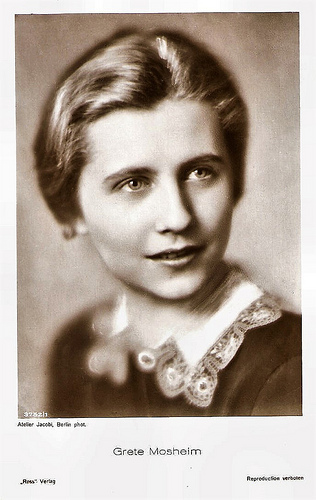
German postcard by Ross Verlag, no. 3752/1, 1928-1929. Photo: Atelier Jacobi.

German postcard by Ross Verlag, no. 4240/1, 1929-1930. Photo: Atelier Jacobi.
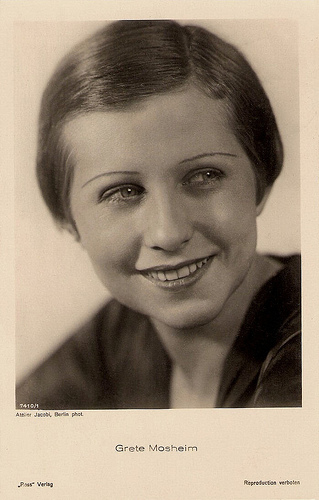
German postcard by Ross Verlag, Berlin, no. 7410/1, 1932-1933. Photo: Atelier Jacobi, Berlin.
A Superstar Almost Overnight
In 1905 Grete Mosheim (originally Mohsheim) was born in Berlin as the daughter of family doctor Markus Mosheim and his wife Clara.
After visiting the Viktoria Lyzeum in Berlin she started her acting career at the age of 17, studying together with Marlene Dietrich at the school of the Deutschen Theaters under Berthold Held in early 1922, as well as at the Reicherschen Hochschule für dramatische Kunst.
Mosheim became established under Max Reinhardt, and - when she was only seventeen - he gave her the chance to substitute in the American play The Speaking Ape when the female lead became ill. Mosheim learned the difficult role from Albert Bassermann in just 24 hours and became a superstar almost overnight.
'Die Mosheim' was a member of the Deutsches Theater, Berlin from 1922 to 1931. From 1931 to 1932 she played at the Lessingtheater, from 1932 to 1933 at the Metropoltheater and afterwards at the Komödienhaus and the Volksbühne.
Mosheim appeared in numerous German films, mostly silent films, starting with Carl Theodor Dreyer’s film Michael (1924) starring Walter Slezak .
Subsequent films were Derby (Max Reichmann, Joe May, 1926), Der Geiger von Florenz/Impetuous Youth (Paul Czinner, 1926), and Junges Blut/Young Blood (Manfred Noa, 1926) starring Lya De Putti .
From 1927 on Mosheim had the female leads in Faschungszäuber/Carnival magic (Rudolf Walther-Fein, 1927) opposite Harry Liedtke, Die spork’schen Jäger/The Hunters of Sporck (Holger-Madsen, 1927) with Otto Gebühr, Primanerliebe/Students' Love (Robert Land, 1927), Höhere Töchter/Higher daughters (Richard Löwenbein, 1928) with Gustav Fröhlich , and Die Siebzehnjährigen/The 17-year-old (Georg Asagaroff, 1928).
In these films of the late 1920s Grete Mosheim often represented the popular type of the proud and mischievous girl.
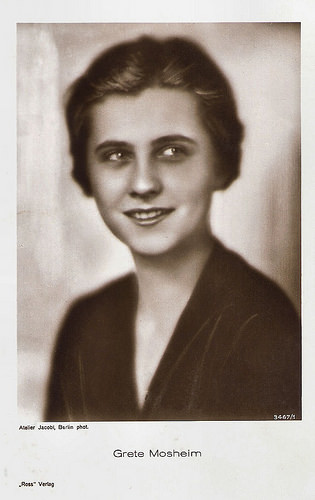
German postcard by Ross Verlag, no. 3467/1, 1928-1929. Photo: Atelier Jacobi, Berlin.
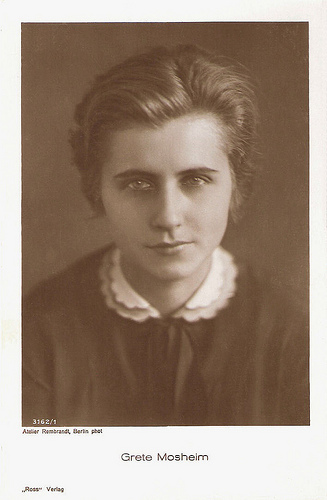
German postcard by Verlag Ross, Berlin, no. 3162/1, 1928-1929. Photo: Atelier Rembrandt, Berlin.
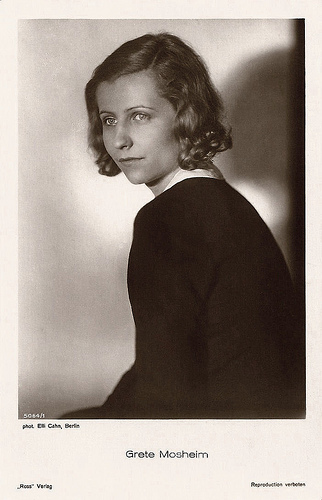
German Postcard by Ross Verlag, no. 5064/1, 1930-1931. Photo: Elli Cahn, Berlin.
Players from Abroad
Until she fled Germany in 1933, Grete Mosheim starred in many early German sound films, including a woman who dies of a forced abortion in Cyankali (Hans Tintner, 1930). Cyankali criticised the German abortion interdiction, reason why it was soon forbidden.
In the early 1930s Mosheim also played Alfred Dreyfus’ ( Fritz Kortner ) wife Lucie in Dreyfus (Richard Oswald, 1930), the daughter of the main character (played by Werner Krauss ) in the period piece Yorck (Gustav Ucicky, 1931), and an audacious steno typist who eventually marries her boss, a banker in Arm wie eine Kirchenmaus/The Church Mouse (Richard Oswald, 1931).
Mosheim was also pre-eminent in the Berlin theatre scene, appearing in a wide variety of roles, and being equally at home in drama and comedy. In 1933 she emigrated to Austria and in 1934 to Britain.
After intensive study, she mastered English well enough to appear in the play Two Share a Dwelling in London in 1934. It became a special success for Mosheim, because she met the American railroad king Howard Gould, who had financed the performance, and who became in 1937 her second husband.
She also played in the British film Car of Dreams (Graham Cutts, Austin Melford, 1935) opposite John Mills . In 1938 Mosheim accompanied Gould to New York. Acceding to Gould's desire she spend more time with him, she retired from acting for a few years, but in 1941 she returned to the stage and played with Players from Abroad, a German speaking theatre company she had help to found.
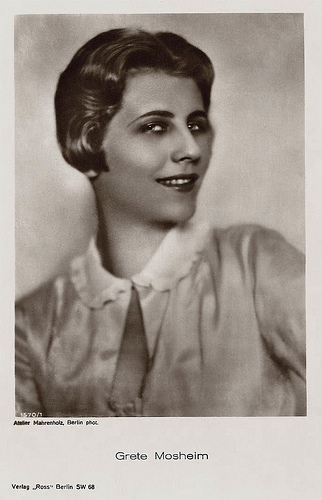
German postcard by Ross Verlag, Berlin, no. 1520/1, 1927-1928. Photo: Atelier Mahrenholz, Berlin.
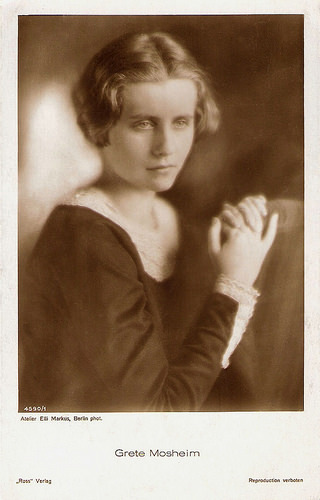
German postcard by Ross Verlag, no. 4590/1, 1929-1930. Photo: Elli Markus.
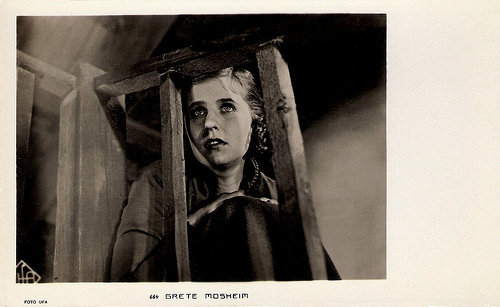
Dutch postcard. Photo: UFA.
Sally Bowles
In 1952 Grete Mosheim appeared in Germany for the first time after the war. First she appeared in Berlin as Sally Bowles in John van Druten‘s play Ich bin eine Kamera (I am a Camera, 1952), based on Christopher Isherwood's Berlin novels. Later this play would be the basis for the musical and film Cabaret.
In 1963 Mosheim received the critics award for performing arts for her part of Hannah Jelkes in Tennessee Williams' play Die Nacht des Leguan (Night of the Iguana) and in 1971 she was honoured with the Deutsche Filmpreis (Filmband in Gold) for her outstanding services to German cinema, plus the Bundesverdienstkreuz in 1974.
After her war Mosheim hardly played in films again, beside her part as the grandmother in the German teenager drama Moritz, lieber Moritz/Moritz, Dear Moritz (Hark Bohm, 1978). She did play on German television though, such as in the Rosa von Praunheim TV documentary Underground and Emigrants (1976), and in fiction series such as the episode …wie die Wolfe/Like the Wolves (Wolfgang Staudte, 1970) of the Krimi series Der Kommissar/The Commissioner, starring Erik Ode.
From 1928 until 1933 Grete Mosheim was married to Austrian actor Oskar Homolka – with whom she had played in Die Rothausgasse, Dreyfus and Moral und Liebe (Georg Jacoby, 1933) - but they divorced. In London Mosheim married a second time to American industrial Howard Gould (1937-1947), and a third time to journalist Robert Cooper. She had no children.
Her sister was stage actress Lore Mosheim aka Lori Lahner and Laurie Lane, who had a film career from the early 1930s on, appearing in films like Summer Storm (Douglas Sirk, 1944). Until her the end of her life, Grete Mosheim lived in New York and often returned to Germany for theatre performances. She died in New York in 1986 from cancer, aged 81.
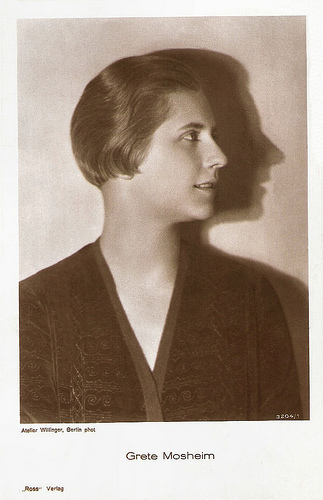
German postcard by Ross Verlag, no. 3204/1. Photo: Atelier Willinger, Berlin.
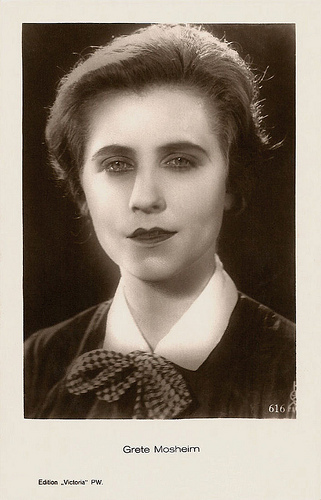
French postcard by Edition Victoria PW, no. 616.
Sources: Thomas Staedeli (Cyranos), USC Libraries, www.filmportal.de, Wikipedia (German and English), and .

German postcard by Ross Verlag, no. 3752/1, 1928-1929. Photo: Atelier Jacobi.

German postcard by Ross Verlag, no. 4240/1, 1929-1930. Photo: Atelier Jacobi.

German postcard by Ross Verlag, Berlin, no. 7410/1, 1932-1933. Photo: Atelier Jacobi, Berlin.
A Superstar Almost Overnight
In 1905 Grete Mosheim (originally Mohsheim) was born in Berlin as the daughter of family doctor Markus Mosheim and his wife Clara.
After visiting the Viktoria Lyzeum in Berlin she started her acting career at the age of 17, studying together with Marlene Dietrich at the school of the Deutschen Theaters under Berthold Held in early 1922, as well as at the Reicherschen Hochschule für dramatische Kunst.
Mosheim became established under Max Reinhardt, and - when she was only seventeen - he gave her the chance to substitute in the American play The Speaking Ape when the female lead became ill. Mosheim learned the difficult role from Albert Bassermann in just 24 hours and became a superstar almost overnight.
'Die Mosheim' was a member of the Deutsches Theater, Berlin from 1922 to 1931. From 1931 to 1932 she played at the Lessingtheater, from 1932 to 1933 at the Metropoltheater and afterwards at the Komödienhaus and the Volksbühne.
Mosheim appeared in numerous German films, mostly silent films, starting with Carl Theodor Dreyer’s film Michael (1924) starring Walter Slezak .
Subsequent films were Derby (Max Reichmann, Joe May, 1926), Der Geiger von Florenz/Impetuous Youth (Paul Czinner, 1926), and Junges Blut/Young Blood (Manfred Noa, 1926) starring Lya De Putti .
From 1927 on Mosheim had the female leads in Faschungszäuber/Carnival magic (Rudolf Walther-Fein, 1927) opposite Harry Liedtke, Die spork’schen Jäger/The Hunters of Sporck (Holger-Madsen, 1927) with Otto Gebühr, Primanerliebe/Students' Love (Robert Land, 1927), Höhere Töchter/Higher daughters (Richard Löwenbein, 1928) with Gustav Fröhlich , and Die Siebzehnjährigen/The 17-year-old (Georg Asagaroff, 1928).
In these films of the late 1920s Grete Mosheim often represented the popular type of the proud and mischievous girl.

German postcard by Ross Verlag, no. 3467/1, 1928-1929. Photo: Atelier Jacobi, Berlin.

German postcard by Verlag Ross, Berlin, no. 3162/1, 1928-1929. Photo: Atelier Rembrandt, Berlin.

German Postcard by Ross Verlag, no. 5064/1, 1930-1931. Photo: Elli Cahn, Berlin.
Players from Abroad
Until she fled Germany in 1933, Grete Mosheim starred in many early German sound films, including a woman who dies of a forced abortion in Cyankali (Hans Tintner, 1930). Cyankali criticised the German abortion interdiction, reason why it was soon forbidden.
In the early 1930s Mosheim also played Alfred Dreyfus’ ( Fritz Kortner ) wife Lucie in Dreyfus (Richard Oswald, 1930), the daughter of the main character (played by Werner Krauss ) in the period piece Yorck (Gustav Ucicky, 1931), and an audacious steno typist who eventually marries her boss, a banker in Arm wie eine Kirchenmaus/The Church Mouse (Richard Oswald, 1931).
Mosheim was also pre-eminent in the Berlin theatre scene, appearing in a wide variety of roles, and being equally at home in drama and comedy. In 1933 she emigrated to Austria and in 1934 to Britain.
After intensive study, she mastered English well enough to appear in the play Two Share a Dwelling in London in 1934. It became a special success for Mosheim, because she met the American railroad king Howard Gould, who had financed the performance, and who became in 1937 her second husband.
She also played in the British film Car of Dreams (Graham Cutts, Austin Melford, 1935) opposite John Mills . In 1938 Mosheim accompanied Gould to New York. Acceding to Gould's desire she spend more time with him, she retired from acting for a few years, but in 1941 she returned to the stage and played with Players from Abroad, a German speaking theatre company she had help to found.

German postcard by Ross Verlag, Berlin, no. 1520/1, 1927-1928. Photo: Atelier Mahrenholz, Berlin.

German postcard by Ross Verlag, no. 4590/1, 1929-1930. Photo: Elli Markus.

Dutch postcard. Photo: UFA.
Sally Bowles
In 1952 Grete Mosheim appeared in Germany for the first time after the war. First she appeared in Berlin as Sally Bowles in John van Druten‘s play Ich bin eine Kamera (I am a Camera, 1952), based on Christopher Isherwood's Berlin novels. Later this play would be the basis for the musical and film Cabaret.
In 1963 Mosheim received the critics award for performing arts for her part of Hannah Jelkes in Tennessee Williams' play Die Nacht des Leguan (Night of the Iguana) and in 1971 she was honoured with the Deutsche Filmpreis (Filmband in Gold) for her outstanding services to German cinema, plus the Bundesverdienstkreuz in 1974.
After her war Mosheim hardly played in films again, beside her part as the grandmother in the German teenager drama Moritz, lieber Moritz/Moritz, Dear Moritz (Hark Bohm, 1978). She did play on German television though, such as in the Rosa von Praunheim TV documentary Underground and Emigrants (1976), and in fiction series such as the episode …wie die Wolfe/Like the Wolves (Wolfgang Staudte, 1970) of the Krimi series Der Kommissar/The Commissioner, starring Erik Ode.
From 1928 until 1933 Grete Mosheim was married to Austrian actor Oskar Homolka – with whom she had played in Die Rothausgasse, Dreyfus and Moral und Liebe (Georg Jacoby, 1933) - but they divorced. In London Mosheim married a second time to American industrial Howard Gould (1937-1947), and a third time to journalist Robert Cooper. She had no children.
Her sister was stage actress Lore Mosheim aka Lori Lahner and Laurie Lane, who had a film career from the early 1930s on, appearing in films like Summer Storm (Douglas Sirk, 1944). Until her the end of her life, Grete Mosheim lived in New York and often returned to Germany for theatre performances. She died in New York in 1986 from cancer, aged 81.

German postcard by Ross Verlag, no. 3204/1. Photo: Atelier Willinger, Berlin.

French postcard by Edition Victoria PW, no. 616.
Sources: Thomas Staedeli (Cyranos), USC Libraries, www.filmportal.de, Wikipedia (German and English), and .
Published on February 27, 2017 22:00
February 26, 2017
Michel Serrault
French stage actor and film star Michel Serrault (1928-2007) appeared from 1954 to 2007 in more than 150 films. He is best known as Albin Mougeotte, alias the outrageous drag queen Zaza Napoli in the play and the film series La Cage aux Folles (The Bird Cage). In the following decades, the comedian also proved to be a noted dramatic film actor. He would win three Césars - the French version of the Oscar, and became one of the grand old men of French cinema.
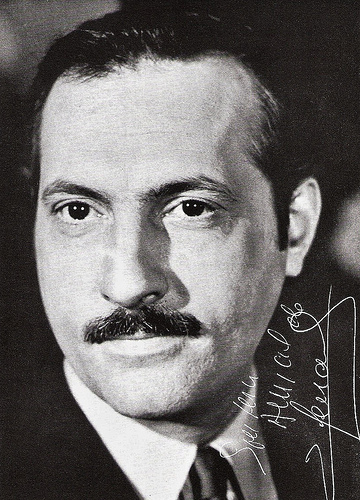
French postcard by La Roue Tourne, Paris.
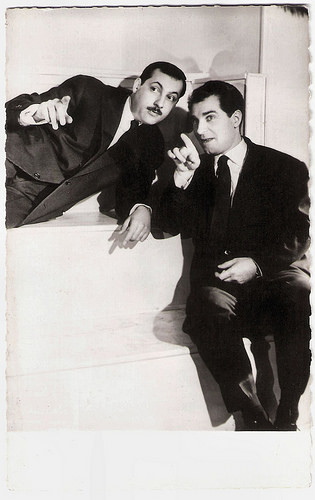
French postcard by Editions P.I., Paris, no. 866. With Jean Poiret.
The bumbling innocent
Michel Serrault was born in Brunoy, south of Paris, in 1928. Although he wanted to be a circus clown, Serrault's parents sent him to a seminary to study for the priesthood. He spent only a few months there before taking-up acting.
His first professional job was in a touring production in Germany of Molière's Les Fourberies de Scapin. After military service in Dijon, he returned to Paris and joined Robert Dhéry's burlesque troupe and appeared in their second hit show, Dugudu.
In 1948, he began his career in the theatre with Robert Dhéry in Les Branquignols. His first film was Ah! Les belles bacchantes/Peek-a-Boo (Jean Loubignac, 1954), starring Robert Dhéry. Then Serrault played in the suspense thriller Les Diaboliques/Diabolique (Henri-Georges Clouzot, 1955), starring Simone Signoret .
In the early 1950s, he met Jean Poiret. Ronald Bergan at The Guardian : “This led to a song-and-comedy cabaret act, and their playing together in 18 films, from 1956 to 1984, and in a number of plays written by Poiret. Usually, Poiret was the calculating smoothie while Serrault was the bumbling innocent. With his flat voice, short stature, nondescript looks and little moustache, Serrault was perfect playing Everyman roles.”
The films he made with Poiret include the box office hit Cette sacrée gamine/Mademoiselle Pigalle (Michel Boisrond, 1956) in which they played two police officers opposite Brigitte Bardot , and Sacha Guitry 's last film, Assassins et Voleurs/Murderers and Thieves (Sacha Guitry, 1957) with Poiret as a man about to commit suicide and Serrault as a burglar who interrupts him.
In the 1960s, Serrault was very active on screen. He made an average of four films a year, most of them comedies for the French market. Internationally known are La Belle Américaine/The American Beauty (Robert Dhèry, Pierre Tchernia, 1961), the title of which refers to a Cadillac; Roger Vadim's Le repos du Guerrier/Warrior's Rest (1962), with BB ; the charming Bébert et L'Omnibus/Bebert and the Train (Yves Robert, 1963), and Le roi de Coeur/King Of Hearts (Philippe de Broca, 1966), in which Serrault played a crazy barber, one of the asylum escapees who have taken over a town.
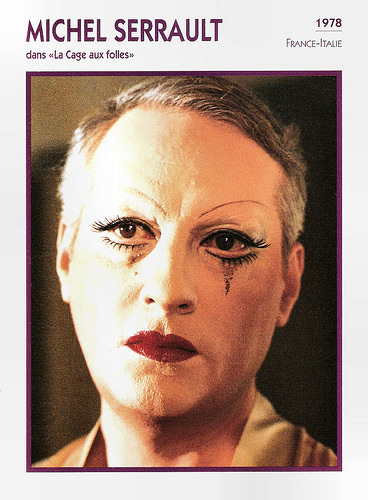
French collectors card in the series 'Portrait de Stars; L'encyclopédie du Cinéma' by Edito Service, 1994. Photo: the Kobal Collection. Publicity still for La Cage aux Folles (Edouard Molinaro, 1978).

French postcard by Editions Hazan, Paris, no. 6274, 1991. Photo: Edimedia. Publicity still for Il lupo e l'agnello/The Wolf and the Lamb (Francesco Massaro, 1980).
The Bird Cage
From February 1973 through 1978, Michel Serrault portrayed the role of Albin/Zaza opposite Jean Poiret in Poiret’s play La Cage aux Folles (The Bird Cage), about a transvestite nightclub in St Tropez. He recreated the role of the effeminate, temperamental and middle-aged performer for the film version of the play, La Cage aux Folles (Edouard Molinaro,1978), now opposite Ugo Tognazzi .
Ronald Bergan in The Guardian : “Albin's volatile yet loving relationship with his longtime companion Renato ( Ugo Tognazzi ) is put to the test when they must pose as a ‘normal’ family to please the puritanical future in-laws of Renato's son. The film, which was to break all box-office records in the US for a foreign-language film to that date”.
For his part, Serrault won both the César award in France and the David di Donatello in Italy. The success lead to progressively awful sequels, La Cage aux Folles II (Edouard Molinaro, 1980) and La cage aux folles 3 - 'Elles' se marine/La Cage aux Folles 3: The Wedding (Georges Lautner, 1985).
He played the neighbour of Carole Laure, Gérard Dépardieu and Patrick Dewaere in the romantic comedy Préparez vos mouchoirs/Get Out Your Handkerchiefs (Bertrand Blier, 1978), which won the Academy Award for Best Foreign Language Film at the 51st Academy Awards.
Other noted films in which he appeared were L'Argent des autres/Dirty money (Christian de Chalonge, 1978) starring Jean-Louis Trintignant , the crime thriller Buffet froid/Cold Cuts (Bertrand Blier, 1979) starring Gérard Depardieu , and Garde à Vue/The Inquisitor (Claude Miller, 1981) for which he won his second César.
He gave another great performance in Les fantômes du chapelier/The Hatter's Ghost (Claude Chabrol, 1982), playing a respected citizen of a small town who murders his bedridden wife and other local women. He appeared opposite Isabelle Adjani in the thriller Mortelle randonnée/Deadly Circuit (Claude Miller, 1983).
Serrault won this third César Award for Best Actor in Nelly et Monsieur Arnaud/Nelly and Mr. Arnaud (Claude Sautet, 1995) with Emmanuelle Béart . Other interesting films were Artemisia (Agnès Merlet, 1997) the biographical film about Italian Baroque painter Artemisia Gentileschi, the crime-comedy Rien ne va plus/The Swindle (Claude Chabrol, 1997) with Isabelle Huppert , and Les enfants du marais/The Children of the Marshland (Jean Becker, 1999).
In 1999, Serrault was awarded the Légion d'Honneur, and two years later, he published his memoirs, Vous Avez Dit Serrault? (Did You Say Serrault?). His later films include Le papillon/The Butterfly (Philippe Muyl, 2002), the WW I drama Joyeux Noël/Happy Christmas (Christian Carion, 2005) and Pars vite et reviens tard/Have Mercy on Us All (Régis Wargnier, 2007) about the return of the Plague to modern Paris, and based on the 2003 novel by Fred Vargas.
In 2007, Serrault died from relapsing polychondritis at his home in Équemauville at age 79. He was buried in Sainte-Catherine's cemetery in Honfleur and was transferred in 2009 to the cemetery of Neuilly-sur-Seine to be near his wife, Juanita Saint-Peyron, and daughter, Caroline, who had died in a car accident in 1977. He was survived by his daughter, actress Nathalie Serrault.
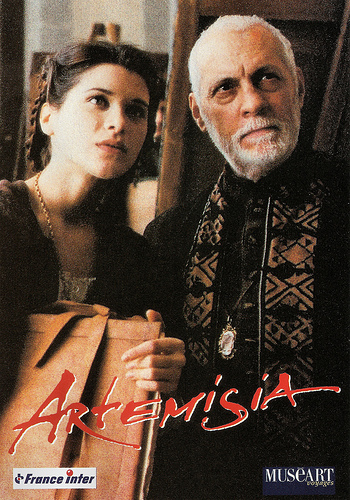
French postcard by Cart.com. Promotion card for the 1998 video release by Arte Video and FilmOffice of Artemisia (Agnès Merlet, 1997) with Valentina Cervi.
Sources: Ronald Bergan (The Guardian), Wikipedia and .

French postcard by La Roue Tourne, Paris.

French postcard by Editions P.I., Paris, no. 866. With Jean Poiret.
The bumbling innocent
Michel Serrault was born in Brunoy, south of Paris, in 1928. Although he wanted to be a circus clown, Serrault's parents sent him to a seminary to study for the priesthood. He spent only a few months there before taking-up acting.
His first professional job was in a touring production in Germany of Molière's Les Fourberies de Scapin. After military service in Dijon, he returned to Paris and joined Robert Dhéry's burlesque troupe and appeared in their second hit show, Dugudu.
In 1948, he began his career in the theatre with Robert Dhéry in Les Branquignols. His first film was Ah! Les belles bacchantes/Peek-a-Boo (Jean Loubignac, 1954), starring Robert Dhéry. Then Serrault played in the suspense thriller Les Diaboliques/Diabolique (Henri-Georges Clouzot, 1955), starring Simone Signoret .
In the early 1950s, he met Jean Poiret. Ronald Bergan at The Guardian : “This led to a song-and-comedy cabaret act, and their playing together in 18 films, from 1956 to 1984, and in a number of plays written by Poiret. Usually, Poiret was the calculating smoothie while Serrault was the bumbling innocent. With his flat voice, short stature, nondescript looks and little moustache, Serrault was perfect playing Everyman roles.”
The films he made with Poiret include the box office hit Cette sacrée gamine/Mademoiselle Pigalle (Michel Boisrond, 1956) in which they played two police officers opposite Brigitte Bardot , and Sacha Guitry 's last film, Assassins et Voleurs/Murderers and Thieves (Sacha Guitry, 1957) with Poiret as a man about to commit suicide and Serrault as a burglar who interrupts him.
In the 1960s, Serrault was very active on screen. He made an average of four films a year, most of them comedies for the French market. Internationally known are La Belle Américaine/The American Beauty (Robert Dhèry, Pierre Tchernia, 1961), the title of which refers to a Cadillac; Roger Vadim's Le repos du Guerrier/Warrior's Rest (1962), with BB ; the charming Bébert et L'Omnibus/Bebert and the Train (Yves Robert, 1963), and Le roi de Coeur/King Of Hearts (Philippe de Broca, 1966), in which Serrault played a crazy barber, one of the asylum escapees who have taken over a town.

French collectors card in the series 'Portrait de Stars; L'encyclopédie du Cinéma' by Edito Service, 1994. Photo: the Kobal Collection. Publicity still for La Cage aux Folles (Edouard Molinaro, 1978).

French postcard by Editions Hazan, Paris, no. 6274, 1991. Photo: Edimedia. Publicity still for Il lupo e l'agnello/The Wolf and the Lamb (Francesco Massaro, 1980).
The Bird Cage
From February 1973 through 1978, Michel Serrault portrayed the role of Albin/Zaza opposite Jean Poiret in Poiret’s play La Cage aux Folles (The Bird Cage), about a transvestite nightclub in St Tropez. He recreated the role of the effeminate, temperamental and middle-aged performer for the film version of the play, La Cage aux Folles (Edouard Molinaro,1978), now opposite Ugo Tognazzi .
Ronald Bergan in The Guardian : “Albin's volatile yet loving relationship with his longtime companion Renato ( Ugo Tognazzi ) is put to the test when they must pose as a ‘normal’ family to please the puritanical future in-laws of Renato's son. The film, which was to break all box-office records in the US for a foreign-language film to that date”.
For his part, Serrault won both the César award in France and the David di Donatello in Italy. The success lead to progressively awful sequels, La Cage aux Folles II (Edouard Molinaro, 1980) and La cage aux folles 3 - 'Elles' se marine/La Cage aux Folles 3: The Wedding (Georges Lautner, 1985).
He played the neighbour of Carole Laure, Gérard Dépardieu and Patrick Dewaere in the romantic comedy Préparez vos mouchoirs/Get Out Your Handkerchiefs (Bertrand Blier, 1978), which won the Academy Award for Best Foreign Language Film at the 51st Academy Awards.
Other noted films in which he appeared were L'Argent des autres/Dirty money (Christian de Chalonge, 1978) starring Jean-Louis Trintignant , the crime thriller Buffet froid/Cold Cuts (Bertrand Blier, 1979) starring Gérard Depardieu , and Garde à Vue/The Inquisitor (Claude Miller, 1981) for which he won his second César.
He gave another great performance in Les fantômes du chapelier/The Hatter's Ghost (Claude Chabrol, 1982), playing a respected citizen of a small town who murders his bedridden wife and other local women. He appeared opposite Isabelle Adjani in the thriller Mortelle randonnée/Deadly Circuit (Claude Miller, 1983).
Serrault won this third César Award for Best Actor in Nelly et Monsieur Arnaud/Nelly and Mr. Arnaud (Claude Sautet, 1995) with Emmanuelle Béart . Other interesting films were Artemisia (Agnès Merlet, 1997) the biographical film about Italian Baroque painter Artemisia Gentileschi, the crime-comedy Rien ne va plus/The Swindle (Claude Chabrol, 1997) with Isabelle Huppert , and Les enfants du marais/The Children of the Marshland (Jean Becker, 1999).
In 1999, Serrault was awarded the Légion d'Honneur, and two years later, he published his memoirs, Vous Avez Dit Serrault? (Did You Say Serrault?). His later films include Le papillon/The Butterfly (Philippe Muyl, 2002), the WW I drama Joyeux Noël/Happy Christmas (Christian Carion, 2005) and Pars vite et reviens tard/Have Mercy on Us All (Régis Wargnier, 2007) about the return of the Plague to modern Paris, and based on the 2003 novel by Fred Vargas.
In 2007, Serrault died from relapsing polychondritis at his home in Équemauville at age 79. He was buried in Sainte-Catherine's cemetery in Honfleur and was transferred in 2009 to the cemetery of Neuilly-sur-Seine to be near his wife, Juanita Saint-Peyron, and daughter, Caroline, who had died in a car accident in 1977. He was survived by his daughter, actress Nathalie Serrault.

French postcard by Cart.com. Promotion card for the 1998 video release by Arte Video and FilmOffice of Artemisia (Agnès Merlet, 1997) with Valentina Cervi.
Sources: Ronald Bergan (The Guardian), Wikipedia and .
Published on February 26, 2017 22:00
February 25, 2017
Isabelle Huppert
Tonight is the 89th Oscars show. Nominated for the Best Actress in a leading role award is French actress Isabelle Huppert (1953) for her amazing turn in Elle (2016). Huppert plays a top exec for a video-game company who turns the tables after being raped in her own home. The versatile and brave actress appeared in more than 90 film and television productions since 1971. She won 89 awards for her work, but the Oscar nomination for Elle is her first.
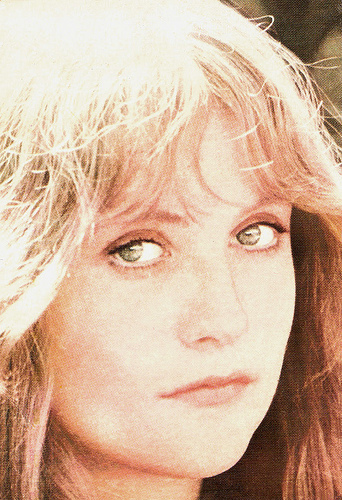
Romanian postcard by Casa Filmului Acin.
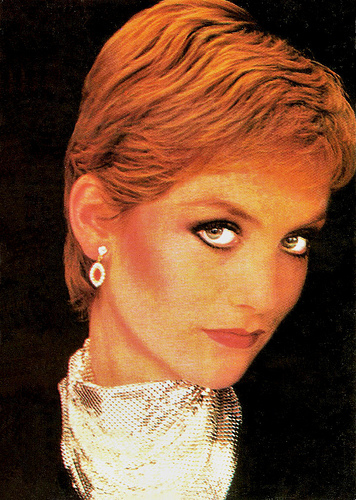
Romanian postcard by Casa Filmului Acin.
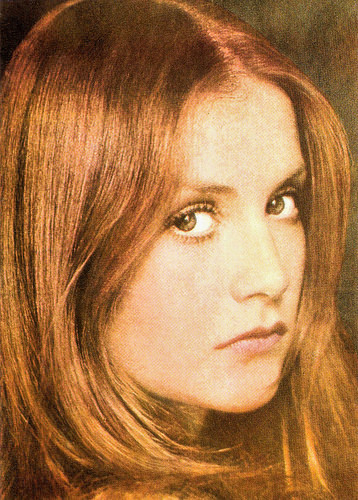
Romanian postcard by Casa Filmului Acin.
Casually Poisoning Her Parents
Isabelle Anne Madeleine Huppert was born in Paris in 1953 (some sources say 1955). She is the youngest of five daughters of Annick Beau, a teacher of English, and Raymond Huppert, a safe manufacturer.
At age 13, she announced her intention to be an actor, and was encouraged by her mother. She studied at the Versailles Conservatoire and later attended the CNSAD (National Conservatory of Dramatic Art of Paris).
Huppert made her film debut in Faustine et le bel été/Faustine and the Beautiful Summer (Nina Companeez, 1972). Five years later, she already had appeared in 15 films and had worked with major directors. She played Romy Schneider 's younger sister in César et Rosalie/Cesar and Rosalie (Claude Sautet, 1972).
In Bertrand Blier’s road movie Les valseuses/Going Places (1974), she played a bored teenager who runs off with three young vagabonds ( Gérard Depardieu , Patrick Dewaere and Miou-Miou). For director Otto Preminger, Huppert made her English-language debut in Rosebud (1975) starring Peter O’Toole .
Her international breakthrough came with her guileless performance as a simple, provincial girl destroyed by a summer romance with a middle-class student in La Dentelliere/The Lacemaker (Claude Goretta, 1977). For this unforgettable portrayal she was awarded with both a BAFTA award (British Academy Award) and a David di Donatello (the Italian Oscar).
At the next Cannes film festival, she won the Best Actress award for Violette Nozière (Claude Chabrol, 1978). In this true story, she portrayed a woman who scandalized France in 1933 by casually poisoning her parents. She tied the award with Jill Clayburgh.
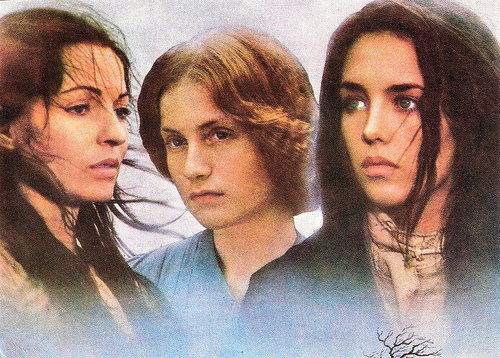
Romanian postcard by Casa Filmului Acin. Photo: publicity still for Les soeurs Brontë/The Bronte Sisters (André Téchniné, 1979) with Marie-France Pisier as Charlotte Bronte, Isabelle Huppert as Anne Bronte, and Isabelle Adjani as Emily Brontë.
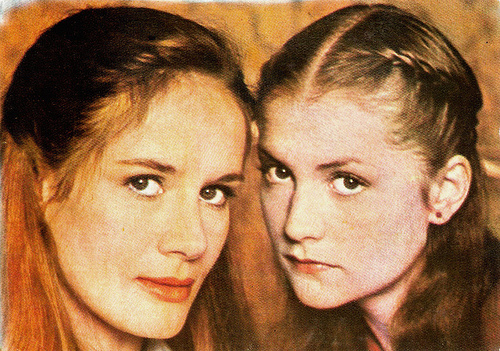
Dominique Sanda and Isabelle Huppert. Romanian postcard by Casa Filmului Acin. Publicity still for Les ailes de la colombe/The Wings of the Dove (Benoît Jacquot, 1981).
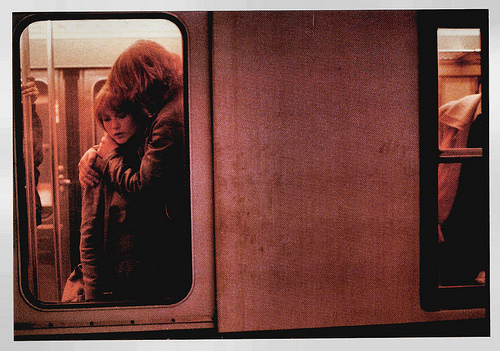
French postcard by Editions La Malibran, Nancy, in the collection Cinéma Couleur, no. MC 39. Publicity still for Loulou (Maurice Pialat, 1979) with Gérard Depardieu .

French card. Photo: publicity still for Loulou (Maurice Pialat, 1980).
Legendary Disaster
Isabelle Huppert made her American film debut in the blockbuster Heaven's Gate (Michael Cimino, 1980), which proved to be a legendary disaster at the box office.
In France she continued to explore enigmatic and emotionally distant characters, such as an upper-class woman who is physically attracted by a young vagabond ( Gérard Depardieu ) in Loulou (Maurice Pialat, 1980), a prostitute in Sauve qui peut (la vie)/Slow Motion (Jean-Luc Godard, 1980), the mistress of Philippe Noiret ’s character in Coup de torchon/Clean Slate (Bertrand Tavernier, 1981) and a Jewish refugee in Coup de foudre/Entre nous (Diane Kurys, 1983).
She used her influence to help non-commercial projects get off the ground, like Joseph Losey's La Truite/The Trout (1982) and sister Caroline Huppert's Signé Charlotte/Sincerely, Charlotte (1984).
For her role in Une Affaire de Femmes/Story of Women (Claude Chabrol, 1988), she received the Volpi Cup for Best Actress at the Venice film festival. This time, she tied with Shirley MacLaine. She won the Volpi Cup again for her role in La Cérémonie (Claude Chabrol, 1995) as a shy but manic and homicidal post-office mistress in a French village. This time she tied the award with her co-star in that film, Sandrine Bonnaire. For La Cérémonie, she also won her only César award.
The offspring of her cinematic relationship with director Claude Chabrol also includes the widely acclaimed literary adaptation Madame Bovary (1991), the crime comedy Rien ne va plus/The Swindle (1997), and the thriller Merci pour le chocolat/Thanks for the Chocolate (2000).
Stuart Jeffries in The Observer about their cooperation: “Huppert has excelled in the spiteful, the nasty, the unpleasant and - regularly - the murderous. More than that, she carries herself with imperious intelligence, and thus seems to be self-conscious about her own wickedness. No doubt that is why Chabrol has cast her so often. He's interested in guilt, manipulativeness and shame - all of which she loves portraying.”
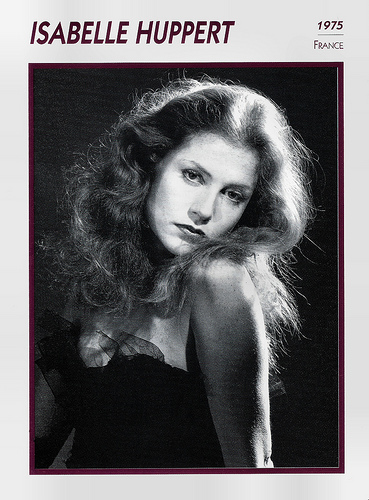
French collectors card in the series 'Portrait de Stars; L'encyclopédie du Cinéma' by Edito Service, 1994. Photo: Harcourt. Caption: France, 1975.
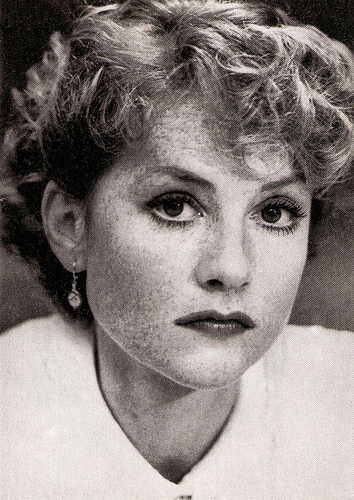
French postcard, no. 222.
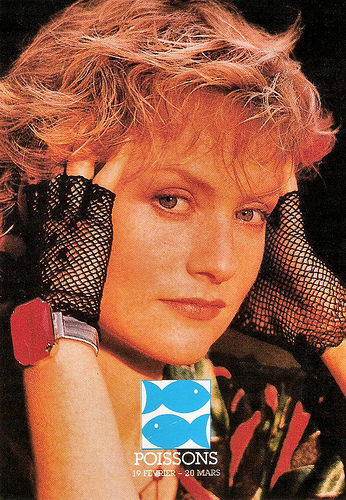
French postcard by Editions F. Nugeron in the Signes Zodiaque series, no 8, Isabelle Huppert - Poissons (Pisces).
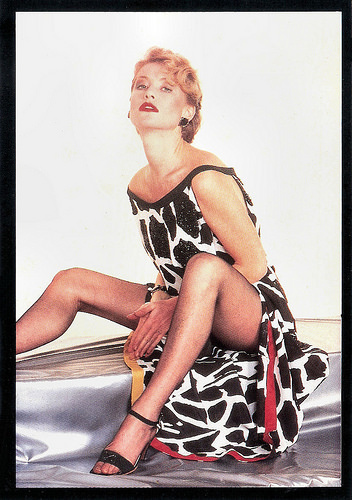
French postcard by Humour a la Carte, Paris, no. ST-159.
Greeted With A Mixture Of Boos And Applause
In 2001, Isabelle Huppert started a new interesting collaboration with Austrian film director Michael Haneke. In La Pianiste/The Piano Teacher (Michael Haneke, 2001), an adaptation of the novel by Nobel prize winner Elfriede Jelinek, she played a sexually repressed and self-destructive piano teacher, who embarks on a dark journey into sadomasochism. Regarded as one of her most impressive turns, her performance won the 2001 acting prize at the Cannes Film Festival. The film also took the Grand Prix (second prize) and was greeted with a mixture of boos and applause, provoking the main debate of the festival.
Huppert continued to work hard. In 2002, the entire cast of the popular black comedy 8 femmes/8 Women (François Ozon, 2002), also including Catherine Deneuve , Danielle Darrieux and Fanny Ardant , was voted Best Actress at the European Film Awards. The same cast won a Silver Bear for Outstanding Artistic Contribution, at the 2002 Berlin film festival.
Then Huppert was back at the set with Haneke for the disturbing Le temps du loup/The Time of the Wolf (Michael Haneke, 2003) with Béatrice Dalle . In Ma mere/My Mother (Christophe Honoré, 2004) based on a novel by George Bataille, Huppert starred as an attractive middle-aged mother who has an incestuous relationship with her teenage son (Louis Garrel).
Since Heaven's Gate, Huppert only made a few more American movies. In The Bedroom Window (Curtis Hanson, 1987) she played Steve Guttenberg’s mistress, and in Amateur (Hal Hartley, 1994) a former nun writing porn. In I [Heart] Huckabees (David O. Russell, 2004) she portrayed author Catherine Vauban, nemesis of existential detectives Dustin Hoffman and Lily Tomlin.
At the 2005 Venice film festival, Huppert received a special Lion for her role in Gabrielle (Patrice Chéreau, 2005). The following year, she reunited with Claude Chabrol for L'ivresse du pouvoir/The Comedy of Power (2006). On the Paris stage, she appeared as the suicidal Hedda Gabler, in Henrik Ibsen's play.
In 1994 she was made Chevalier (Knight) of the Ordre national du Mérite and in 2005 she was promoted to Officier (Officer). She was also made Chevalier (Knight) of the Légion d'honneur in 1999 and was promoted to Officier (Officer) in 2009. With her spouse, director Ronnie Chammah, she has three children: actress Lolita Chammah (1983), Lorenzo Chammah (1986) and Angelo Chammah (1997). Huppert likes to keep her private life private though. Her work is her main issue in interviews.
In 2012, two of her films competed for the Palme d'Or in Cannes: Amour/Love (Michael Haneke, 2012) and the South-Korean production Da-reun na-ra-e-seo/In Another Country (Sang-soo Hong, 2012). Her part as the daughter of Jean-Louis Trintignant and Emmanuelle Riva in Amour also got her another César nomination.
In Valley of Love (Guillaume Nicloux, 2015, she reunited with Gérard Depardieu . They play two famous actors who used to be a couple and had a son 25 years ago. They reunite after the son's death, and receive a letter asking them to visit five places at Death Valley, which will make the son reappear. Valley of Love was selected to compete for the Palme d'Or at the 2015 Cannes Film Festival.
But Elle (Paul Verhoeven, 2016) was the real sensation lately. This provocative and disturbing comedy-thriller divided many film fans, as a Verhoeven picture should. Elle got rave reviews in leading newspapers but was snubbed by the jury of the Cannes Film Festival and by the Academy in the 2016 Best Foreign Language Film Category. To me it's one of the wildest and most disturbing films of this century in the disguise of a stylish thriller. The core of the film is one of the most daring and sexy performances of a 50-plus actress ever. With each new view, Elle and Huppert get more interesting.
Xan Brooks at The Guardian : "Turn off the lights and let the horror begin. Paul Verhoeven’s new film, Elle, is an outrageous black comedy, volatile and deadly; a film that opens up with a sexual assault and then cleans off the blood ahead of a posh restaurant dinner. (...) Huppert gives a performance of imperious fury, holding the audience at bay, almost goading us to disown her. Audaciously, Elle presents her not so much as a victim but as the casualty of a world she is very much a part of; maybe (still more troublingly) an accessory to."
Since Cannes, Elle and its lead actress did win 41 international awards, including Golden Globes for both Best foreign film and Best leading actress. Tonight (or tomorrow in Europe) we will know if Isabelle Huppert adds her first Oscar to this list.
Trailer Coup de torchon/Clean Slate (1981). Source: WorleyClarence (YouTube).
Trailer Amour/Love (2012). Source: MovieclipsTrailers (YouTube).
French trailer Elle (Paul Verhoeven, 2016). Source: cinémaniak (YouTube).
Sources: Stuart Jeffries (The Observer), Xan Brooks (The Guardian) Rebecca Flint Marx (AllMovie), Yahoo! Movies, Wikipedia and .

Romanian postcard by Casa Filmului Acin.

Romanian postcard by Casa Filmului Acin.

Romanian postcard by Casa Filmului Acin.
Casually Poisoning Her Parents
Isabelle Anne Madeleine Huppert was born in Paris in 1953 (some sources say 1955). She is the youngest of five daughters of Annick Beau, a teacher of English, and Raymond Huppert, a safe manufacturer.
At age 13, she announced her intention to be an actor, and was encouraged by her mother. She studied at the Versailles Conservatoire and later attended the CNSAD (National Conservatory of Dramatic Art of Paris).
Huppert made her film debut in Faustine et le bel été/Faustine and the Beautiful Summer (Nina Companeez, 1972). Five years later, she already had appeared in 15 films and had worked with major directors. She played Romy Schneider 's younger sister in César et Rosalie/Cesar and Rosalie (Claude Sautet, 1972).
In Bertrand Blier’s road movie Les valseuses/Going Places (1974), she played a bored teenager who runs off with three young vagabonds ( Gérard Depardieu , Patrick Dewaere and Miou-Miou). For director Otto Preminger, Huppert made her English-language debut in Rosebud (1975) starring Peter O’Toole .
Her international breakthrough came with her guileless performance as a simple, provincial girl destroyed by a summer romance with a middle-class student in La Dentelliere/The Lacemaker (Claude Goretta, 1977). For this unforgettable portrayal she was awarded with both a BAFTA award (British Academy Award) and a David di Donatello (the Italian Oscar).
At the next Cannes film festival, she won the Best Actress award for Violette Nozière (Claude Chabrol, 1978). In this true story, she portrayed a woman who scandalized France in 1933 by casually poisoning her parents. She tied the award with Jill Clayburgh.

Romanian postcard by Casa Filmului Acin. Photo: publicity still for Les soeurs Brontë/The Bronte Sisters (André Téchniné, 1979) with Marie-France Pisier as Charlotte Bronte, Isabelle Huppert as Anne Bronte, and Isabelle Adjani as Emily Brontë.

Dominique Sanda and Isabelle Huppert. Romanian postcard by Casa Filmului Acin. Publicity still for Les ailes de la colombe/The Wings of the Dove (Benoît Jacquot, 1981).

French postcard by Editions La Malibran, Nancy, in the collection Cinéma Couleur, no. MC 39. Publicity still for Loulou (Maurice Pialat, 1979) with Gérard Depardieu .

French card. Photo: publicity still for Loulou (Maurice Pialat, 1980).
Legendary Disaster
Isabelle Huppert made her American film debut in the blockbuster Heaven's Gate (Michael Cimino, 1980), which proved to be a legendary disaster at the box office.
In France she continued to explore enigmatic and emotionally distant characters, such as an upper-class woman who is physically attracted by a young vagabond ( Gérard Depardieu ) in Loulou (Maurice Pialat, 1980), a prostitute in Sauve qui peut (la vie)/Slow Motion (Jean-Luc Godard, 1980), the mistress of Philippe Noiret ’s character in Coup de torchon/Clean Slate (Bertrand Tavernier, 1981) and a Jewish refugee in Coup de foudre/Entre nous (Diane Kurys, 1983).
She used her influence to help non-commercial projects get off the ground, like Joseph Losey's La Truite/The Trout (1982) and sister Caroline Huppert's Signé Charlotte/Sincerely, Charlotte (1984).
For her role in Une Affaire de Femmes/Story of Women (Claude Chabrol, 1988), she received the Volpi Cup for Best Actress at the Venice film festival. This time, she tied with Shirley MacLaine. She won the Volpi Cup again for her role in La Cérémonie (Claude Chabrol, 1995) as a shy but manic and homicidal post-office mistress in a French village. This time she tied the award with her co-star in that film, Sandrine Bonnaire. For La Cérémonie, she also won her only César award.
The offspring of her cinematic relationship with director Claude Chabrol also includes the widely acclaimed literary adaptation Madame Bovary (1991), the crime comedy Rien ne va plus/The Swindle (1997), and the thriller Merci pour le chocolat/Thanks for the Chocolate (2000).
Stuart Jeffries in The Observer about their cooperation: “Huppert has excelled in the spiteful, the nasty, the unpleasant and - regularly - the murderous. More than that, she carries herself with imperious intelligence, and thus seems to be self-conscious about her own wickedness. No doubt that is why Chabrol has cast her so often. He's interested in guilt, manipulativeness and shame - all of which she loves portraying.”

French collectors card in the series 'Portrait de Stars; L'encyclopédie du Cinéma' by Edito Service, 1994. Photo: Harcourt. Caption: France, 1975.

French postcard, no. 222.

French postcard by Editions F. Nugeron in the Signes Zodiaque series, no 8, Isabelle Huppert - Poissons (Pisces).

French postcard by Humour a la Carte, Paris, no. ST-159.
Greeted With A Mixture Of Boos And Applause
In 2001, Isabelle Huppert started a new interesting collaboration with Austrian film director Michael Haneke. In La Pianiste/The Piano Teacher (Michael Haneke, 2001), an adaptation of the novel by Nobel prize winner Elfriede Jelinek, she played a sexually repressed and self-destructive piano teacher, who embarks on a dark journey into sadomasochism. Regarded as one of her most impressive turns, her performance won the 2001 acting prize at the Cannes Film Festival. The film also took the Grand Prix (second prize) and was greeted with a mixture of boos and applause, provoking the main debate of the festival.
Huppert continued to work hard. In 2002, the entire cast of the popular black comedy 8 femmes/8 Women (François Ozon, 2002), also including Catherine Deneuve , Danielle Darrieux and Fanny Ardant , was voted Best Actress at the European Film Awards. The same cast won a Silver Bear for Outstanding Artistic Contribution, at the 2002 Berlin film festival.
Then Huppert was back at the set with Haneke for the disturbing Le temps du loup/The Time of the Wolf (Michael Haneke, 2003) with Béatrice Dalle . In Ma mere/My Mother (Christophe Honoré, 2004) based on a novel by George Bataille, Huppert starred as an attractive middle-aged mother who has an incestuous relationship with her teenage son (Louis Garrel).
Since Heaven's Gate, Huppert only made a few more American movies. In The Bedroom Window (Curtis Hanson, 1987) she played Steve Guttenberg’s mistress, and in Amateur (Hal Hartley, 1994) a former nun writing porn. In I [Heart] Huckabees (David O. Russell, 2004) she portrayed author Catherine Vauban, nemesis of existential detectives Dustin Hoffman and Lily Tomlin.
At the 2005 Venice film festival, Huppert received a special Lion for her role in Gabrielle (Patrice Chéreau, 2005). The following year, she reunited with Claude Chabrol for L'ivresse du pouvoir/The Comedy of Power (2006). On the Paris stage, she appeared as the suicidal Hedda Gabler, in Henrik Ibsen's play.
In 1994 she was made Chevalier (Knight) of the Ordre national du Mérite and in 2005 she was promoted to Officier (Officer). She was also made Chevalier (Knight) of the Légion d'honneur in 1999 and was promoted to Officier (Officer) in 2009. With her spouse, director Ronnie Chammah, she has three children: actress Lolita Chammah (1983), Lorenzo Chammah (1986) and Angelo Chammah (1997). Huppert likes to keep her private life private though. Her work is her main issue in interviews.
In 2012, two of her films competed for the Palme d'Or in Cannes: Amour/Love (Michael Haneke, 2012) and the South-Korean production Da-reun na-ra-e-seo/In Another Country (Sang-soo Hong, 2012). Her part as the daughter of Jean-Louis Trintignant and Emmanuelle Riva in Amour also got her another César nomination.
In Valley of Love (Guillaume Nicloux, 2015, she reunited with Gérard Depardieu . They play two famous actors who used to be a couple and had a son 25 years ago. They reunite after the son's death, and receive a letter asking them to visit five places at Death Valley, which will make the son reappear. Valley of Love was selected to compete for the Palme d'Or at the 2015 Cannes Film Festival.
But Elle (Paul Verhoeven, 2016) was the real sensation lately. This provocative and disturbing comedy-thriller divided many film fans, as a Verhoeven picture should. Elle got rave reviews in leading newspapers but was snubbed by the jury of the Cannes Film Festival and by the Academy in the 2016 Best Foreign Language Film Category. To me it's one of the wildest and most disturbing films of this century in the disguise of a stylish thriller. The core of the film is one of the most daring and sexy performances of a 50-plus actress ever. With each new view, Elle and Huppert get more interesting.
Xan Brooks at The Guardian : "Turn off the lights and let the horror begin. Paul Verhoeven’s new film, Elle, is an outrageous black comedy, volatile and deadly; a film that opens up with a sexual assault and then cleans off the blood ahead of a posh restaurant dinner. (...) Huppert gives a performance of imperious fury, holding the audience at bay, almost goading us to disown her. Audaciously, Elle presents her not so much as a victim but as the casualty of a world she is very much a part of; maybe (still more troublingly) an accessory to."
Since Cannes, Elle and its lead actress did win 41 international awards, including Golden Globes for both Best foreign film and Best leading actress. Tonight (or tomorrow in Europe) we will know if Isabelle Huppert adds her first Oscar to this list.
Trailer Coup de torchon/Clean Slate (1981). Source: WorleyClarence (YouTube).
Trailer Amour/Love (2012). Source: MovieclipsTrailers (YouTube).
French trailer Elle (Paul Verhoeven, 2016). Source: cinémaniak (YouTube).
Sources: Stuart Jeffries (The Observer), Xan Brooks (The Guardian) Rebecca Flint Marx (AllMovie), Yahoo! Movies, Wikipedia and .
Published on February 25, 2017 22:00
February 24, 2017
Imported from the USA: Brad Pitt
Brad Pitt (1963) is executive producer of Barry Jenkins' masterpiece Moonlight (2016), nominated for eight 2017 Oscars, which will be presented tomorrow 26 February. The attractive and intelligent American actor and producer is one the most successful film makers of his era. He has received multiple awards and nominations including an Academy Award as producer under his own company Plan B Entertainment. As an actor, Pitt wildly varies his film choices, appearing in everything from high-concept popcorn flicks such as Troy (2004) to adventurous critic-bait like Inglourious Basterds (2009) and The Tree of Life (2011). He has received Best Actor Oscar nominations for The Curious Case of Benjamin Button (2008) and Moneyball (2011). Will the astonishing successes keep on coming?
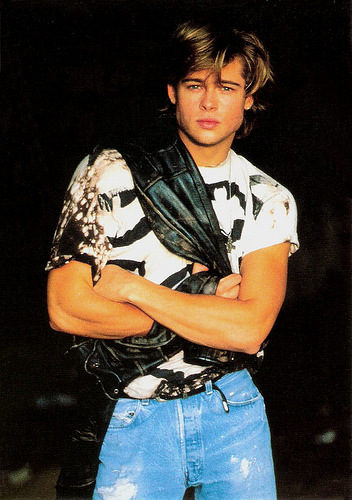
British postcard by Heroes Publishing LTD., London, no. SPC2617.
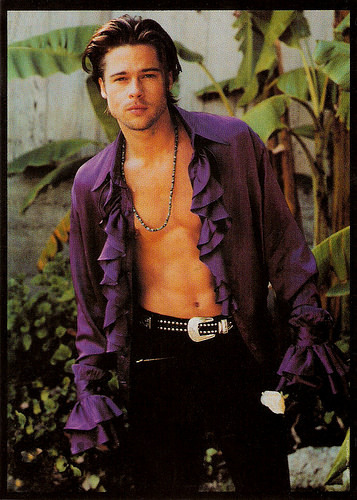
British postcard by Box Office, no. BO 034.
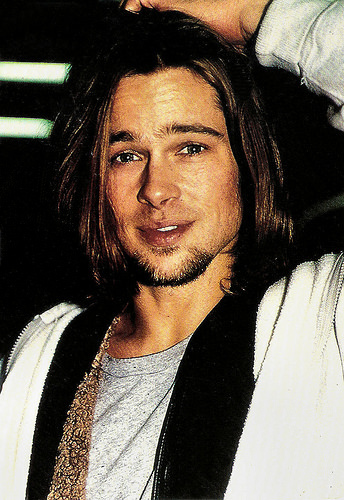
British postcard by Heroes Publishing LTD., London, no. SPC2569.
A wickedly sexy hitchhiker
William Bradley ‘Brad’ Pitt was born in 1963 in Shawnee, Oklahoma, and brought up in a strict Baptist household. His parents were William Alvin Pitt, who ran a trucking company, and Jane Etta (née Hillhouse), a school counsellor. He has a younger brother, Douglas (Doug) Pitt, and a younger sister, Julie Neal Pitt.
Following his graduation from high school, Pitt enrolled in the University of Missouri in 1982, majoring in journalism. Two weeks before earning his degree, he left the university and moved to Los Angeles, where he took acting lessons and worked odd jobs. Reportedly he chauffeured strippers to private parties, waited tables, and wore a giant chicken suit for a local restaurant chain. Pitt's acting career began with uncredited parts in such films as Less Than Zero (Marek Kanievska, 1987).
His television debut came in May 1987 with a two-episode role on the soap opera Another World. In November of the same year Pitt had a guest appearance on the sitcom Growing Pains. He appeared in four episodes of the legendary prime time soap opera Dallas (1987-1988). In 1989 he made his film debut with a featured role in the slasher Cutting Class (Rospo Pallenberg, 1989) with Donovan Leitch.
Pitt first gained recognition as a wickedly sexy hitchhiker in the road movie Thelma & Louise (Ridley Scott, 1991), who seduces Thelma (Geena Davis) and robs her blind. Biograpy.com : “Pitt's combination of charming bad boy charisma and sensual playfulness—particularly in a fiery love scene with Geena Davis—made him a genuine sex symbol (and wore out the rewind button on many a VCR).“
His first leading roles in big-budget productions came with the dramas A River Runs Through It (Robert Redford, 1992) and Legends of the Fall (Edward Zwick, 1994), for which Pitt received his first Golden Globe Award nomination, in the Best Actor category. Both films gave the actor a much-needed chance to prove that he had talent in addition to his handsome looks. He then starred opposite Tom Cruise and Antonio Banderas as the brooding, gothic vampire Louis de Pointe du Lac in the romantic horror film Interview with the Vampire (Neil Jordan, 1994), based on the novel by Anne Rice.
Pitt also garnered attention for a brief appearance in the cult hit True Romance (Tony Scott, 1993) as a stoner named Floyd, providing comic relief to the action film written by Quentin Tarantino. Pitt gave critically acclaimed performances as an emotionally tortured detective investigating a series of gruesome crimes in the horror-thriller Se7en (David Fincher, 1995) and as visionary mental patient Jeffrey Goines in 12 Monkeys (Terry Gilliam, 1995). This latter role got him a Golden Globe Award for Best Supporting Actor and an Academy Award nomination. Seven earned $327 million at the international box office. He also starred in the legal drama Sleepers (Barry Levinson, 1996).
Pitt then played Tyler Durden, the mysterious and anti-materialistic soap salesman in Fight Club (David Fincher, 1999) about a bloody diversion for young professional males. This unglamorous, disturbing role was an interesting but odd choice for a man voted 'Most Sexy Actor Alive' by virtually every entertainment publication currently in circulation, but the film became a cult.
Jason Clark in his review at AllMovie : "A definitive case of a movie that has yet to find its time, David Fincher's unnerving and cataclysmic look at the male psyche takes no prisoners and makes no apologies, which is precisely why the film is so powerful. A kind of stepchild to Stanley Kubrick's A Clockwork Orange in terms of its thematic relevancy and misunderstood nature, Fight Club looks and feels like almost nothing that has preceded it. Brad Pitt, Edward Norton, and Helena Bonham Carter all successfully subvert their onscreen personas, and give fully committed portrayals that never get buried in the film's dazzling set pieces."
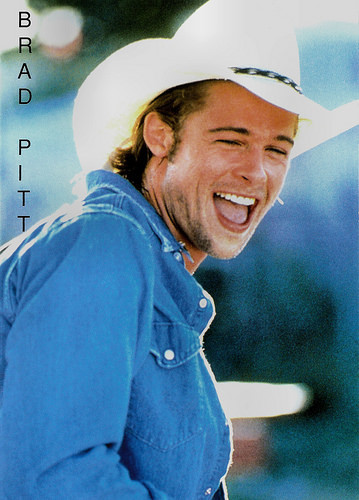
British postcard by Heroes Publishing Ltd, London, no. SPC2506. Publicity still for Thelma & Louise (Ridley Scott, 1991).
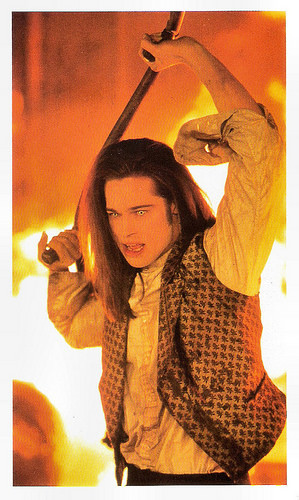
British Exclusive Collectors' Artcard. Photo: Geffen Pictures. Publicity still for Interview with the Vampire (Neil Jordan, 1994). Caption: Louis de Pointe Du Lac (Brad Pitt) is a broken man, devastated by the loss of his beloved wife and infant daughter. Becoming a vampire is his only relief.
Male chemistry
Brad Pitt was cast as an Irish Gypsy boxer with a barely intelligible accent in the British gangster film Snatch (2000), Guy Ritchie's eagerly anticipated follow-up to Lock, Stock and Two Smoking Barrels. He then played Rusty Ryan in Ocean's Eleven (Steven Soderbergh, 2001) with George Clooney. It was a remake of the Rat Pack classic about a group of criminals who plot to rob a string of casinos.
Well received by critics, Ocean's Eleven was highly successful at the box office, earning $450 million worldwide. The heist film had two sequels, Ocean's Twelve (Steven Soderbergh, 2004) and Ocean's Thirteen (Steven Soderbergh, 2007). Ocean's Twelve earned $362 million worldwide, and the third sequel earned $311 million at the international box office. CNN 's Paul Clinton: "Plus, Clooney and Pitt have the best male chemistry since Paul Newman and Robert Redford."
Another commercial success was Troy (Wolfgang Petersen, 2004), based on The Iliad by Homer. For his part as Achilles, Pitt spent six months sword training and it helped establish his appeal as action star. Troy was the first film produced by Plan B Entertainment, a film production company he had founded two years earlier with Jennifer Aniston and Brad Grey, CEO of Paramount Pictures.
Pitt then had a hit with the stylish action comedy Mr. & Mrs. Smith (Doug Liman, 2005), opposite Angela Jolie. Mr. & Mrs. Smith earned $478 million worldwide, making it one of the biggest hits of 2005. Pitt starred opposite Cate Blanchett in Alejandro González Iñárritu's multi-narrative drama Babel (2006). His performance was critically well-received. Babel received seven Academy and Golden Globe award nominations, winning the Best Drama Golden Globe, and earned Pitt a nomination for the Best Supporting Actor Golden Globe.
Pitt then appeared in the black comedy Burn After Reading (Joel and Ethan Coen, 2008), his first collaboration with the Coen brothers. The film and Pitt's supporting role received a positive reception from critics. Andrew Pulver at The Guardian: "Clocking in at a crisp 95 minutes, Burn After Reading is a tightly wound, slickly plotted spy comedy (...) Pitt, in fact, gets the best of the funny stuff, but has by some way the least screen time of all the principal cast."
The actor received his second Academy Award nomination for his leading performances in The Curious Case of Benjamin Button (David Fincher, 2008). Pitt played the title character, who is born as a 70-year-old man and ages in reverse. The Curious Case of Benjamin Button received thirteen Academy Award nominations in total, and grossed $329 million at the box office worldwide.
Pitt's next leading role came in the blistering war film Inglourious Basterds (Quentin Tarantino, 2009) which premiered at the Cannes Film Festival. Pitt played Lieutenant Aldo Raine, an American resistance fighter battling Nazis in German-occupied France. The film was a box office hit, taking $311 million worldwide, and garnered generally favourable reviews. Perry Seibert at AllMovie : "Tarantino has always cast his films to perfection, and the performers here know how to get the most out of the ornate language. Brad Pitt uses a hilarious Southern drawl, and his attempts at speaking Italian are a comic highlight."
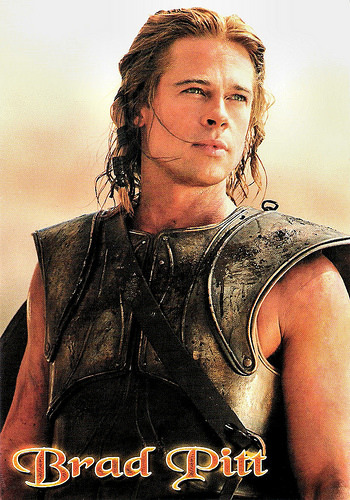
Italian postcard by EdiBas S.r.l., Torino, no. Pc 1.338. Photo: Grazia Neri. Publicity still for Troy (Wolfgang Petersen, 2004).
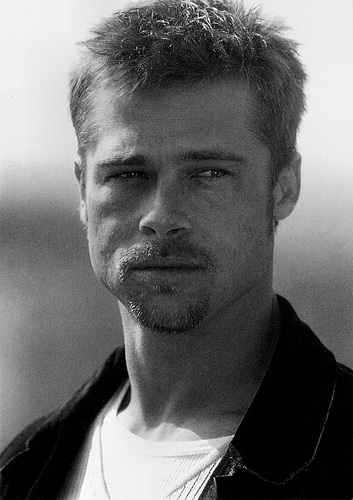
British postcard by Heroes Publishing Ltd, London, no. SPC 2742.
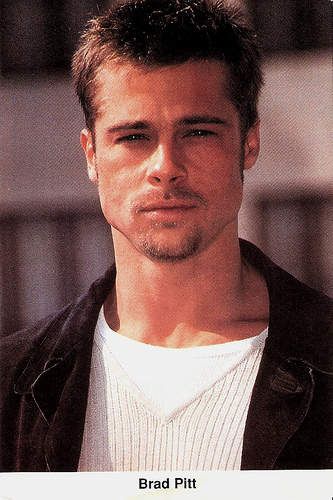
British postcard by A Bigger Splash, Manchester, no. X743, 1997.
Brangelina
Brad Pitt had another commercial success with World War Z (Marc Forster, 2013), a thriller about a zombie apocalypse. Pitt produced the film which grossed $540 million against a production budget of $190 million. He also produced The Departed (Martin Scorsese, 2006) and 12 Years a Slave (Steve McQueen, 2013), both of which won the Academy Award for Best Picture.
Another success as a producer and as an actor was The Tree of Life (Terrence Malick, 2009), based on the autobiography of Solomon Northup. In this experimental drama, he gave one of the best performances of his career, playing a disciplinarian father. At AllMovie , Rebecca Flint Marx describes The Tree of Life as "a sprawling, cerebral phantasmorgia on the meaning of life and death". The film became one of the critical sensations of the year."
Pitt's list of successes seems endless. His productions Moneyball (Bennett Miller, 2011) and the comedy-drama The Big Short (Adam McKay, 2015), garnered Best Picture nominations too. Moneyball received six Academy Award nominations including Best Actor for Pitt. Besides this Oscar nomination, his role as Billy Beane in Moneyball also earned him Best Actor nominations from the BAFTA, the Broadcast Film Association, the Golden Globes, and won him the New York Film Critics Circle award (the award was also for his role in Tree of Life).
Not only his work, his personal life is also the subject of wide publicity. In the late 1980s and early 1990s, Pitt was involved in successive relationships with several of his co-stars, including Robin Givens, Jill Schoelen and Juliette Lewis. In addition, Pitt had a much-publicized romance and engagement to his Seven co-star Gwyneth Paltrow, whom he dated from 1994 to 1997.
From 2000 till 2005, he was married to actress Jennifer Aniston. During their divorce, he fell in love with actress Angelina Jolie on the set of Mr. & Mrs. Smith. The entertainment media dubbed the couple 'Brangelina' and they married in 2014. They have six children together, three of whom were adopted internationally. In 2015, Pitt starred opposite Jolie, in her third directorial effort, By the Sea, a romantic drama about a marriage in crisis, based on her screenplay. In September 2016, Angelina Jolie filed in real life for divorce from Pitt.
Pitt’s most recent film is the World War II romantic thriller Allied (Robert Zemeckis, 2016) in which he and Marion Cotillard play an intelligence officer and resistance fighter, respectively, who fall in love during a mission to kill a German official. In 2017 Brad Pitt can be seen with Tilda Swinton in War Machine (David Michôd, 2017), a satire of America's war with Afghanistan with a focus on the people running the campaign. Announced is also World War Z 2 (2017), with David Fincher rumoured as director.
As an executive producer, Brad Pitt has another amazingly huge success with Moonlight (2016), directed by Barry Jenkins. The film about the life of a young black and gay man struggling to find his place in the world while growing up in a rough neighborhood of Miami, is nominated for eight Academy Awards. The film gets our vote!
Trailer 12 Monkeys (Terry Gilliam, 1995). Source: Movieclips (YouTube).
Trailer Snatch (Guy Ritchie, 2000). Source: Juliana Mendes Mendonça (YouTube).
Trailer Inglourious Basterds (Quentin Tarantino, 2009), Source: Movieclips Trailer Vault (YouTube).
Sources: Rebecca Flint Marx (AllMovie), Jason Clark (AllMovie), Perry Seibert (AllMovie), Paul Clinton (CNN), Andrew Pulver (The Guardian), Biography.com, Wikipedia, and .

British postcard by Heroes Publishing LTD., London, no. SPC2617.

British postcard by Box Office, no. BO 034.

British postcard by Heroes Publishing LTD., London, no. SPC2569.
A wickedly sexy hitchhiker
William Bradley ‘Brad’ Pitt was born in 1963 in Shawnee, Oklahoma, and brought up in a strict Baptist household. His parents were William Alvin Pitt, who ran a trucking company, and Jane Etta (née Hillhouse), a school counsellor. He has a younger brother, Douglas (Doug) Pitt, and a younger sister, Julie Neal Pitt.
Following his graduation from high school, Pitt enrolled in the University of Missouri in 1982, majoring in journalism. Two weeks before earning his degree, he left the university and moved to Los Angeles, where he took acting lessons and worked odd jobs. Reportedly he chauffeured strippers to private parties, waited tables, and wore a giant chicken suit for a local restaurant chain. Pitt's acting career began with uncredited parts in such films as Less Than Zero (Marek Kanievska, 1987).
His television debut came in May 1987 with a two-episode role on the soap opera Another World. In November of the same year Pitt had a guest appearance on the sitcom Growing Pains. He appeared in four episodes of the legendary prime time soap opera Dallas (1987-1988). In 1989 he made his film debut with a featured role in the slasher Cutting Class (Rospo Pallenberg, 1989) with Donovan Leitch.
Pitt first gained recognition as a wickedly sexy hitchhiker in the road movie Thelma & Louise (Ridley Scott, 1991), who seduces Thelma (Geena Davis) and robs her blind. Biograpy.com : “Pitt's combination of charming bad boy charisma and sensual playfulness—particularly in a fiery love scene with Geena Davis—made him a genuine sex symbol (and wore out the rewind button on many a VCR).“
His first leading roles in big-budget productions came with the dramas A River Runs Through It (Robert Redford, 1992) and Legends of the Fall (Edward Zwick, 1994), for which Pitt received his first Golden Globe Award nomination, in the Best Actor category. Both films gave the actor a much-needed chance to prove that he had talent in addition to his handsome looks. He then starred opposite Tom Cruise and Antonio Banderas as the brooding, gothic vampire Louis de Pointe du Lac in the romantic horror film Interview with the Vampire (Neil Jordan, 1994), based on the novel by Anne Rice.
Pitt also garnered attention for a brief appearance in the cult hit True Romance (Tony Scott, 1993) as a stoner named Floyd, providing comic relief to the action film written by Quentin Tarantino. Pitt gave critically acclaimed performances as an emotionally tortured detective investigating a series of gruesome crimes in the horror-thriller Se7en (David Fincher, 1995) and as visionary mental patient Jeffrey Goines in 12 Monkeys (Terry Gilliam, 1995). This latter role got him a Golden Globe Award for Best Supporting Actor and an Academy Award nomination. Seven earned $327 million at the international box office. He also starred in the legal drama Sleepers (Barry Levinson, 1996).
Pitt then played Tyler Durden, the mysterious and anti-materialistic soap salesman in Fight Club (David Fincher, 1999) about a bloody diversion for young professional males. This unglamorous, disturbing role was an interesting but odd choice for a man voted 'Most Sexy Actor Alive' by virtually every entertainment publication currently in circulation, but the film became a cult.
Jason Clark in his review at AllMovie : "A definitive case of a movie that has yet to find its time, David Fincher's unnerving and cataclysmic look at the male psyche takes no prisoners and makes no apologies, which is precisely why the film is so powerful. A kind of stepchild to Stanley Kubrick's A Clockwork Orange in terms of its thematic relevancy and misunderstood nature, Fight Club looks and feels like almost nothing that has preceded it. Brad Pitt, Edward Norton, and Helena Bonham Carter all successfully subvert their onscreen personas, and give fully committed portrayals that never get buried in the film's dazzling set pieces."

British postcard by Heroes Publishing Ltd, London, no. SPC2506. Publicity still for Thelma & Louise (Ridley Scott, 1991).

British Exclusive Collectors' Artcard. Photo: Geffen Pictures. Publicity still for Interview with the Vampire (Neil Jordan, 1994). Caption: Louis de Pointe Du Lac (Brad Pitt) is a broken man, devastated by the loss of his beloved wife and infant daughter. Becoming a vampire is his only relief.
Male chemistry
Brad Pitt was cast as an Irish Gypsy boxer with a barely intelligible accent in the British gangster film Snatch (2000), Guy Ritchie's eagerly anticipated follow-up to Lock, Stock and Two Smoking Barrels. He then played Rusty Ryan in Ocean's Eleven (Steven Soderbergh, 2001) with George Clooney. It was a remake of the Rat Pack classic about a group of criminals who plot to rob a string of casinos.
Well received by critics, Ocean's Eleven was highly successful at the box office, earning $450 million worldwide. The heist film had two sequels, Ocean's Twelve (Steven Soderbergh, 2004) and Ocean's Thirteen (Steven Soderbergh, 2007). Ocean's Twelve earned $362 million worldwide, and the third sequel earned $311 million at the international box office. CNN 's Paul Clinton: "Plus, Clooney and Pitt have the best male chemistry since Paul Newman and Robert Redford."
Another commercial success was Troy (Wolfgang Petersen, 2004), based on The Iliad by Homer. For his part as Achilles, Pitt spent six months sword training and it helped establish his appeal as action star. Troy was the first film produced by Plan B Entertainment, a film production company he had founded two years earlier with Jennifer Aniston and Brad Grey, CEO of Paramount Pictures.
Pitt then had a hit with the stylish action comedy Mr. & Mrs. Smith (Doug Liman, 2005), opposite Angela Jolie. Mr. & Mrs. Smith earned $478 million worldwide, making it one of the biggest hits of 2005. Pitt starred opposite Cate Blanchett in Alejandro González Iñárritu's multi-narrative drama Babel (2006). His performance was critically well-received. Babel received seven Academy and Golden Globe award nominations, winning the Best Drama Golden Globe, and earned Pitt a nomination for the Best Supporting Actor Golden Globe.
Pitt then appeared in the black comedy Burn After Reading (Joel and Ethan Coen, 2008), his first collaboration with the Coen brothers. The film and Pitt's supporting role received a positive reception from critics. Andrew Pulver at The Guardian: "Clocking in at a crisp 95 minutes, Burn After Reading is a tightly wound, slickly plotted spy comedy (...) Pitt, in fact, gets the best of the funny stuff, but has by some way the least screen time of all the principal cast."
The actor received his second Academy Award nomination for his leading performances in The Curious Case of Benjamin Button (David Fincher, 2008). Pitt played the title character, who is born as a 70-year-old man and ages in reverse. The Curious Case of Benjamin Button received thirteen Academy Award nominations in total, and grossed $329 million at the box office worldwide.
Pitt's next leading role came in the blistering war film Inglourious Basterds (Quentin Tarantino, 2009) which premiered at the Cannes Film Festival. Pitt played Lieutenant Aldo Raine, an American resistance fighter battling Nazis in German-occupied France. The film was a box office hit, taking $311 million worldwide, and garnered generally favourable reviews. Perry Seibert at AllMovie : "Tarantino has always cast his films to perfection, and the performers here know how to get the most out of the ornate language. Brad Pitt uses a hilarious Southern drawl, and his attempts at speaking Italian are a comic highlight."

Italian postcard by EdiBas S.r.l., Torino, no. Pc 1.338. Photo: Grazia Neri. Publicity still for Troy (Wolfgang Petersen, 2004).

British postcard by Heroes Publishing Ltd, London, no. SPC 2742.

British postcard by A Bigger Splash, Manchester, no. X743, 1997.
Brangelina
Brad Pitt had another commercial success with World War Z (Marc Forster, 2013), a thriller about a zombie apocalypse. Pitt produced the film which grossed $540 million against a production budget of $190 million. He also produced The Departed (Martin Scorsese, 2006) and 12 Years a Slave (Steve McQueen, 2013), both of which won the Academy Award for Best Picture.
Another success as a producer and as an actor was The Tree of Life (Terrence Malick, 2009), based on the autobiography of Solomon Northup. In this experimental drama, he gave one of the best performances of his career, playing a disciplinarian father. At AllMovie , Rebecca Flint Marx describes The Tree of Life as "a sprawling, cerebral phantasmorgia on the meaning of life and death". The film became one of the critical sensations of the year."
Pitt's list of successes seems endless. His productions Moneyball (Bennett Miller, 2011) and the comedy-drama The Big Short (Adam McKay, 2015), garnered Best Picture nominations too. Moneyball received six Academy Award nominations including Best Actor for Pitt. Besides this Oscar nomination, his role as Billy Beane in Moneyball also earned him Best Actor nominations from the BAFTA, the Broadcast Film Association, the Golden Globes, and won him the New York Film Critics Circle award (the award was also for his role in Tree of Life).
Not only his work, his personal life is also the subject of wide publicity. In the late 1980s and early 1990s, Pitt was involved in successive relationships with several of his co-stars, including Robin Givens, Jill Schoelen and Juliette Lewis. In addition, Pitt had a much-publicized romance and engagement to his Seven co-star Gwyneth Paltrow, whom he dated from 1994 to 1997.
From 2000 till 2005, he was married to actress Jennifer Aniston. During their divorce, he fell in love with actress Angelina Jolie on the set of Mr. & Mrs. Smith. The entertainment media dubbed the couple 'Brangelina' and they married in 2014. They have six children together, three of whom were adopted internationally. In 2015, Pitt starred opposite Jolie, in her third directorial effort, By the Sea, a romantic drama about a marriage in crisis, based on her screenplay. In September 2016, Angelina Jolie filed in real life for divorce from Pitt.
Pitt’s most recent film is the World War II romantic thriller Allied (Robert Zemeckis, 2016) in which he and Marion Cotillard play an intelligence officer and resistance fighter, respectively, who fall in love during a mission to kill a German official. In 2017 Brad Pitt can be seen with Tilda Swinton in War Machine (David Michôd, 2017), a satire of America's war with Afghanistan with a focus on the people running the campaign. Announced is also World War Z 2 (2017), with David Fincher rumoured as director.
As an executive producer, Brad Pitt has another amazingly huge success with Moonlight (2016), directed by Barry Jenkins. The film about the life of a young black and gay man struggling to find his place in the world while growing up in a rough neighborhood of Miami, is nominated for eight Academy Awards. The film gets our vote!
Trailer 12 Monkeys (Terry Gilliam, 1995). Source: Movieclips (YouTube).
Trailer Snatch (Guy Ritchie, 2000). Source: Juliana Mendes Mendonça (YouTube).
Trailer Inglourious Basterds (Quentin Tarantino, 2009), Source: Movieclips Trailer Vault (YouTube).
Sources: Rebecca Flint Marx (AllMovie), Jason Clark (AllMovie), Perry Seibert (AllMovie), Paul Clinton (CNN), Andrew Pulver (The Guardian), Biography.com, Wikipedia, and .
Published on February 24, 2017 22:00
Paul van Yperen's Blog
- Paul van Yperen's profile
- 13 followers
Paul van Yperen isn't a Goodreads Author
(yet),
but they
do have a blog,
so here are some recent posts imported from
their feed.



